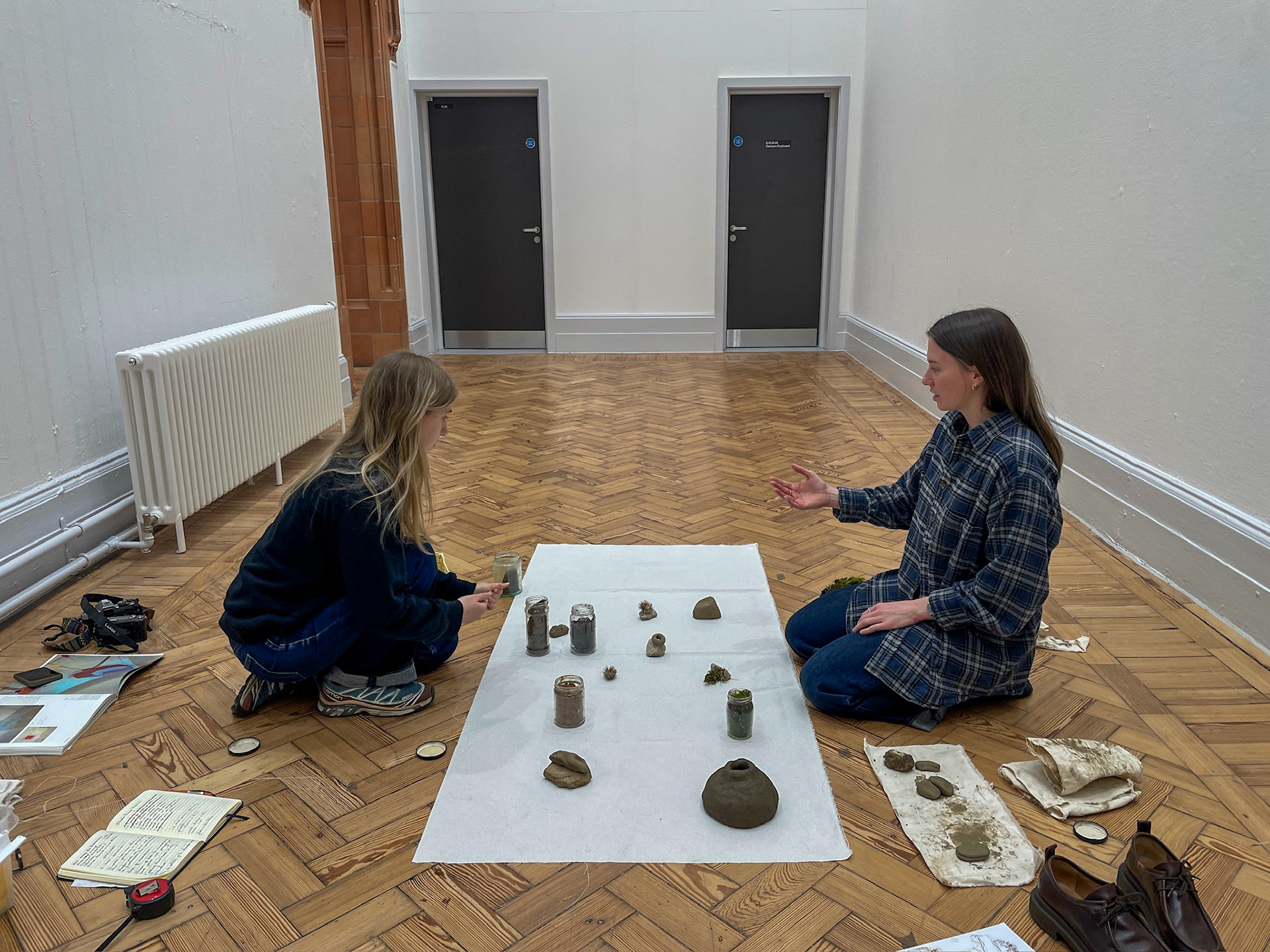I have decided to apply for the Vertical Gallery commission. I believe this opportunity would provide me with a new way of looking at my work from the point of view of an installation, a collaboration and a communal project. The ethos of my making involves people, a community of makers, fellow nature enthusiasts and varied making processes.
Abbie Fowler, during the Venice Biennale, Oct 2024.
I approached final-year Fine Art and Art History student Abbie Fowler, whom I met during the study trip to Venice, to ask whether she would be interested in joining me with this project.
During the October Venice Biennale trip, we discovered that there were many parallels in our working practices. This trip uncovered our shared love of documenting the natural earth and the people that make up the spaces in the land.
A ceramicist and land artist, Abbie researches and explores art and ecology while investigating human interactions with the landscape.
When discovering that the Vertical Gallery commission had the possibility of collaboration, Abbie and I decided that by bringing together the two of our disciplines and thought processes to create one interchangeable project, we would have the opportunity to merge our ideas to form a collaborative, multidisciplinary project, spreading over two departments and specialities.
Vertical Gallery Expression of Interest form, Jan 2025
Vertical Gallery Expression of Interest
This is our expression of interest, which we applied for the Vertical Gallery commission.
Our proposal was to hold community workshops in order to explore and cherish the natural land and bring more awareness to the importance of the sustainability of making on location. Due to our shared interest in foraging and researching the environment of the Peak District, we aim to provide small, community-led workshops to express and spread awareness of location-based materiality whilst proving that craft and art can create a geographical relationship between memory and place.
By submitting this idea for the Vertical Gallery, it would provide us with the budget and support to make this project successful, and provide more opportunities to develop our ideas and showcase them through an interactive direct result of our findings through the Vertical Gallery exhibition.
Next steps...
After submitting our expression of interest, we got through to the long-list stage. This required us to make a pitch in front of the judging panel to express our intentions for the commission. Abbie and I had various meetings during these two weeks to develop a more detailed plan for what we envision for our workshops and how we see it fitting within the context of the Vertical Gallery.
I have included some of my notes from these meetings:

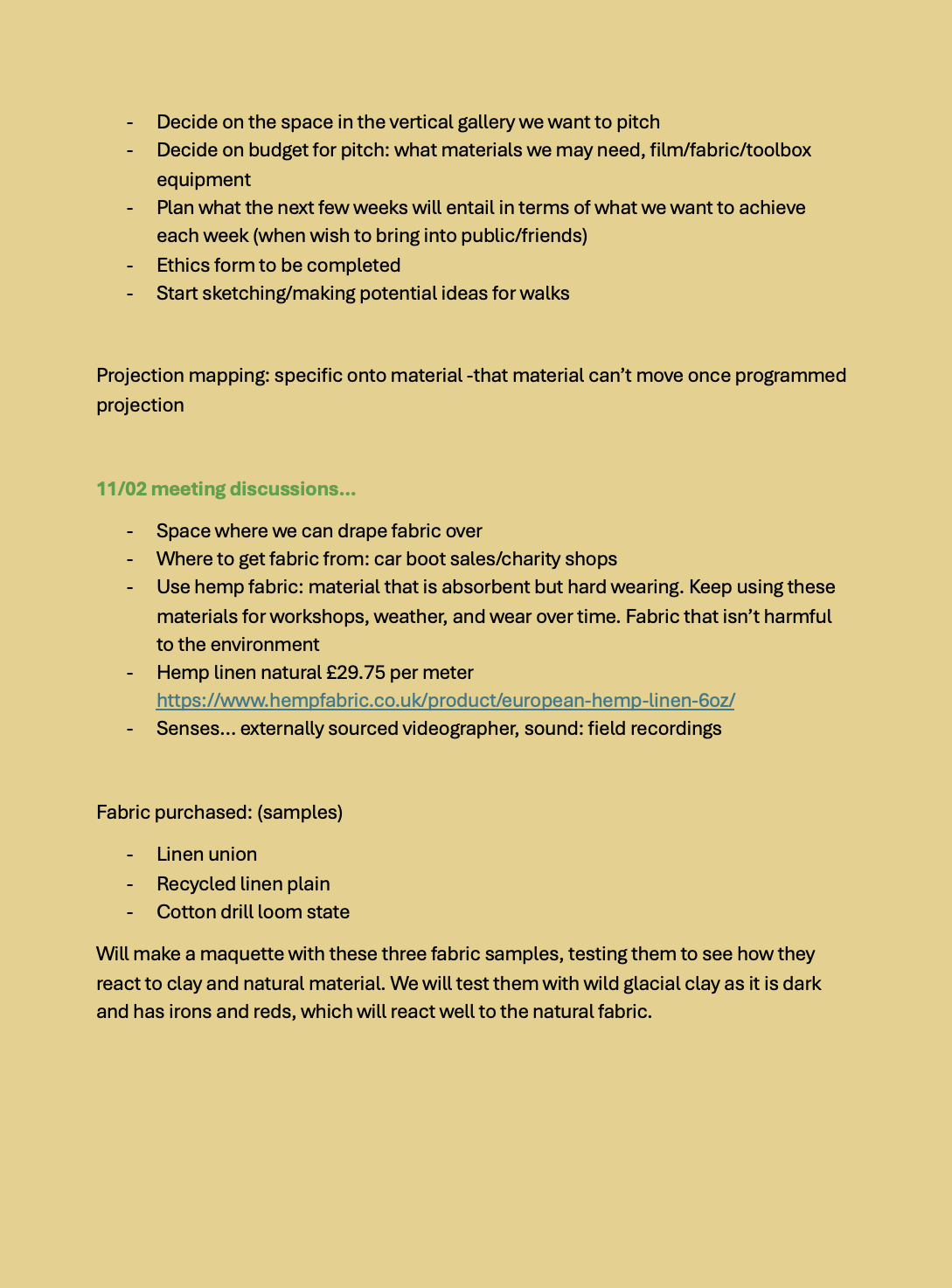
As we only had two weeks to develop our ideas and make our pitch, we had to think fairly quickly about how we wanted the project to unfold and think carefully about our budget, timeline and any other practicalities. We had the idea of presenting our workshops through film documentation for the exhibition. This would be shown through a monitor on the wall, documenting the day workshops we would be taking people on in the Peak District.
We would also present our findings through a large fabric hanging. It would form a working space, a communal tapestry that is worked on throughout the day, drawn on with natural materials sourced from the area by the people in the workshops. As a group, we would make marks on the tapestry with local clays that I had dug from the area.
It is important for us that the workshops are held in the Peak District. Abbie and I have a connection to this area and have worked in this location before. Holding our work here also links my projects together and provides a fluid overlap between my personal project and the collaboration.
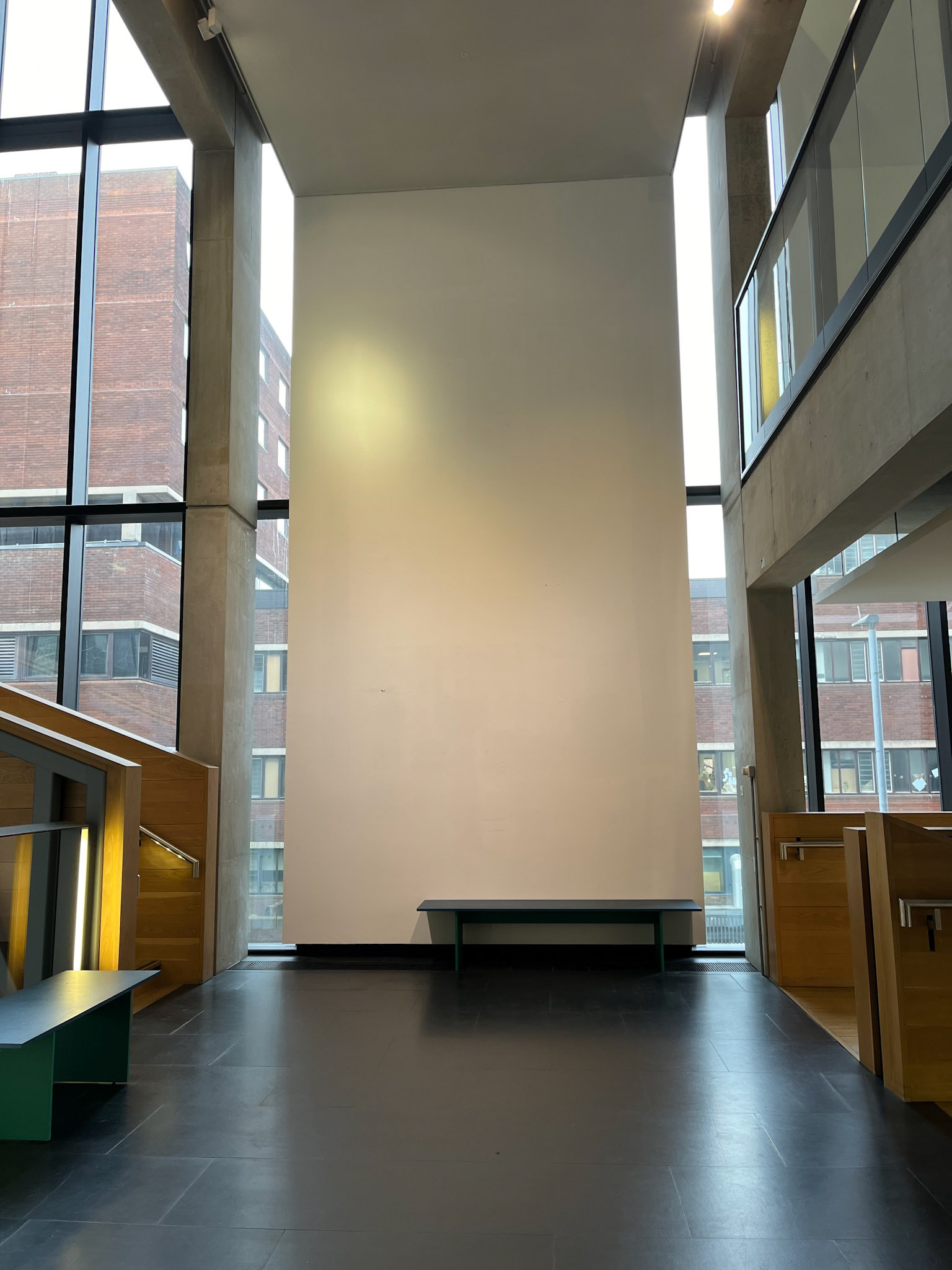
Deciding on the space
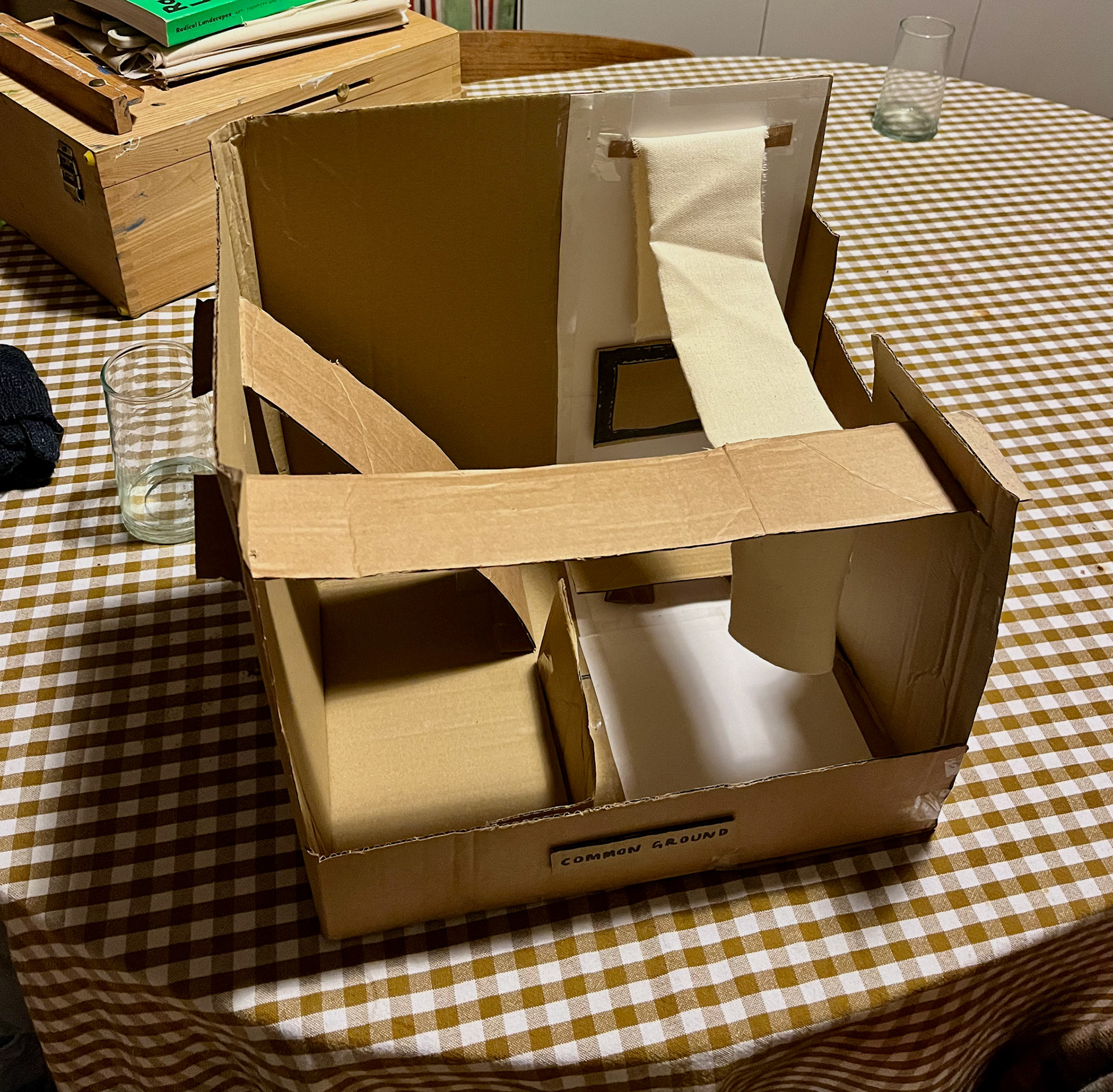
Making a model for the pitch
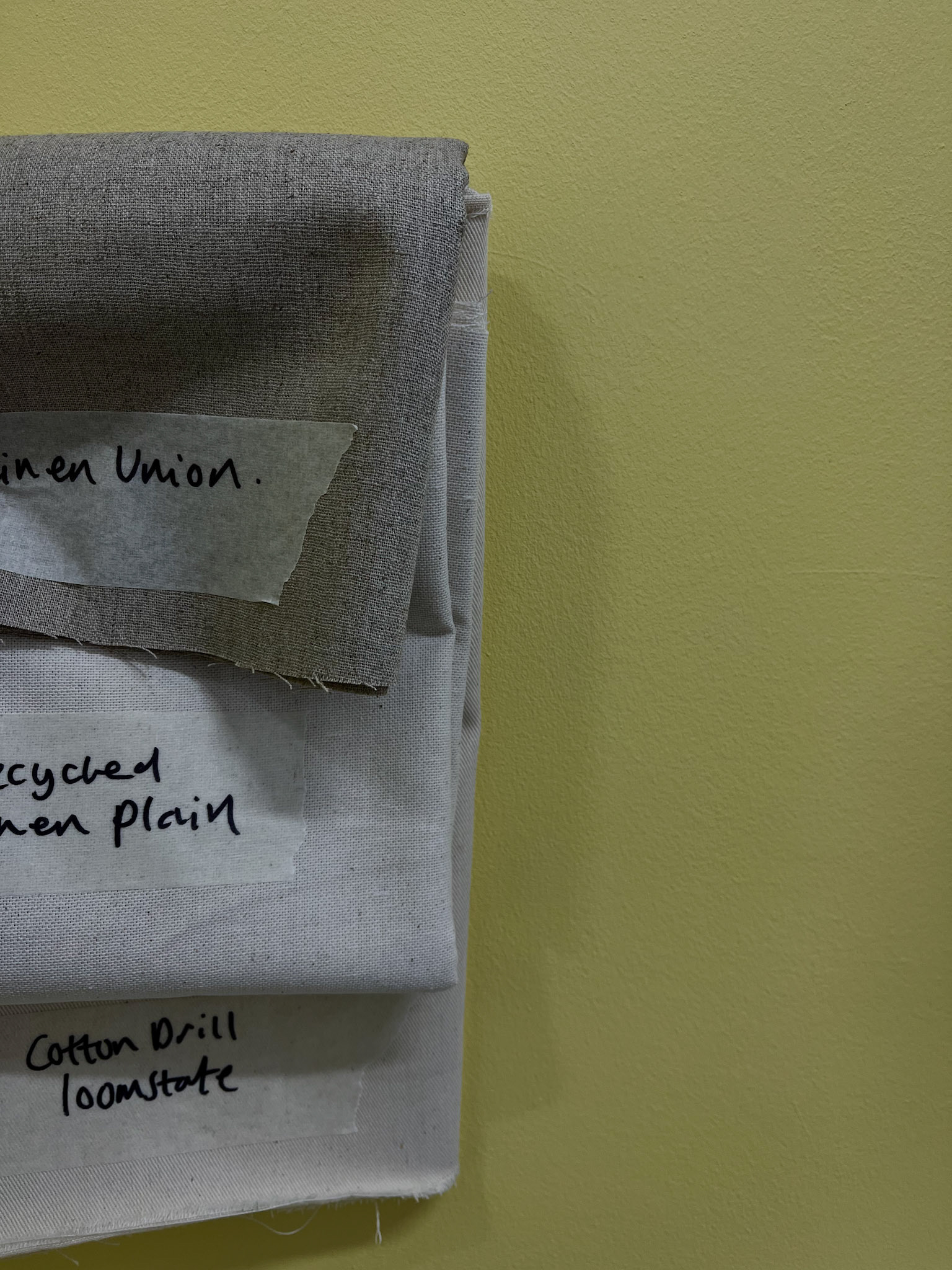
Deciding on fabric
We decided that we wanted to pitch for the space on the first floor, with our fabric tapestry hanging over the bannister through the space over the length of the floor. This way, viewers can see the tapestry on either side. We have been researching different fabrics, as it is important to be as sustainable as possible with the materials we are working with.
The pitch
This is the final pitch that we presented to the panel. It outlines the key outcomes we wish to have for the Vertical Gallery, including a mood board showing where we have gathered the information from, a timeline for the desired dates for each task, and a price breakdown for our budget. We have requested for a quite high budget, which on reflection, might have been an overestimate, as we have requested to outsource a videogrpaher.
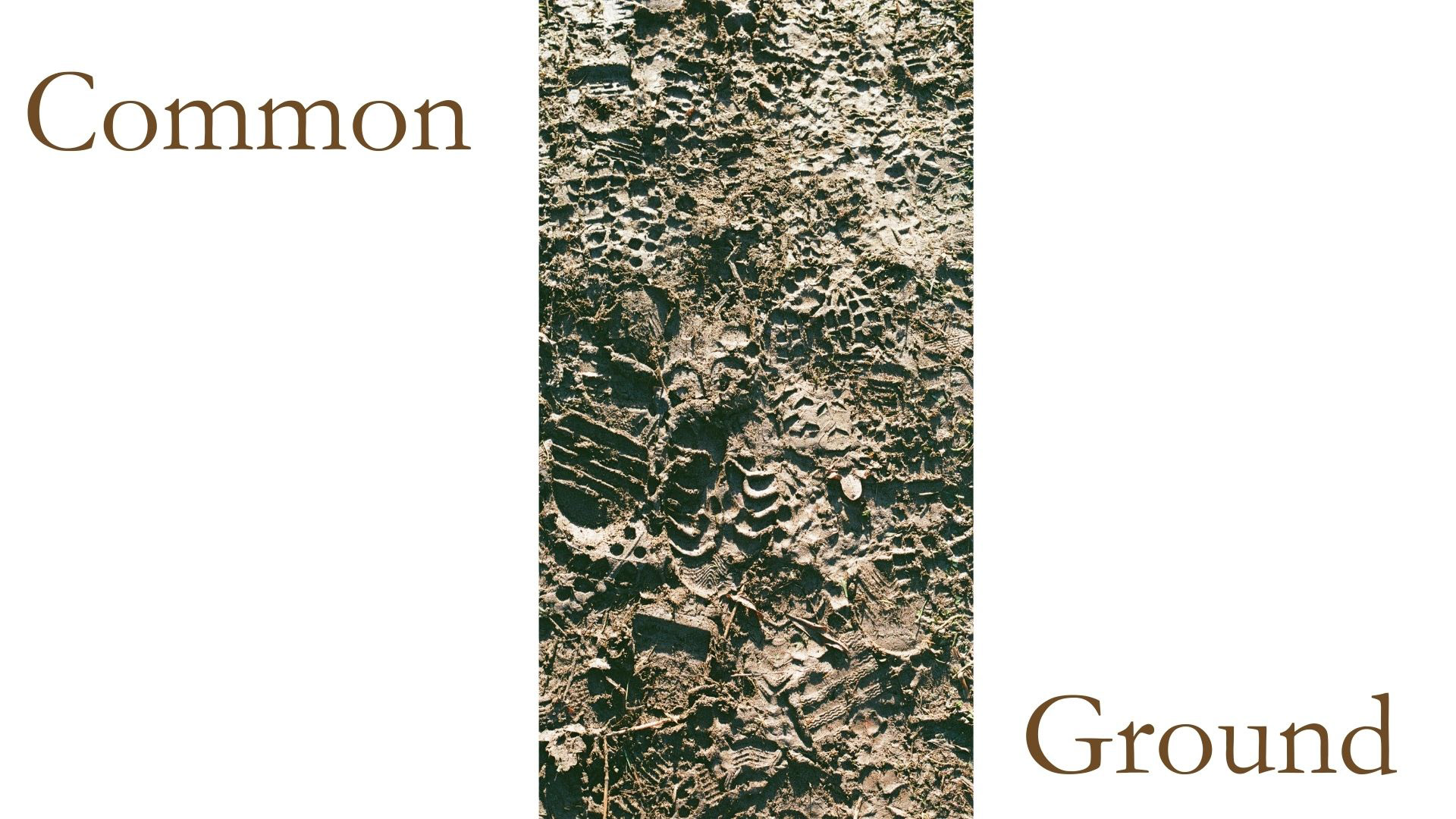

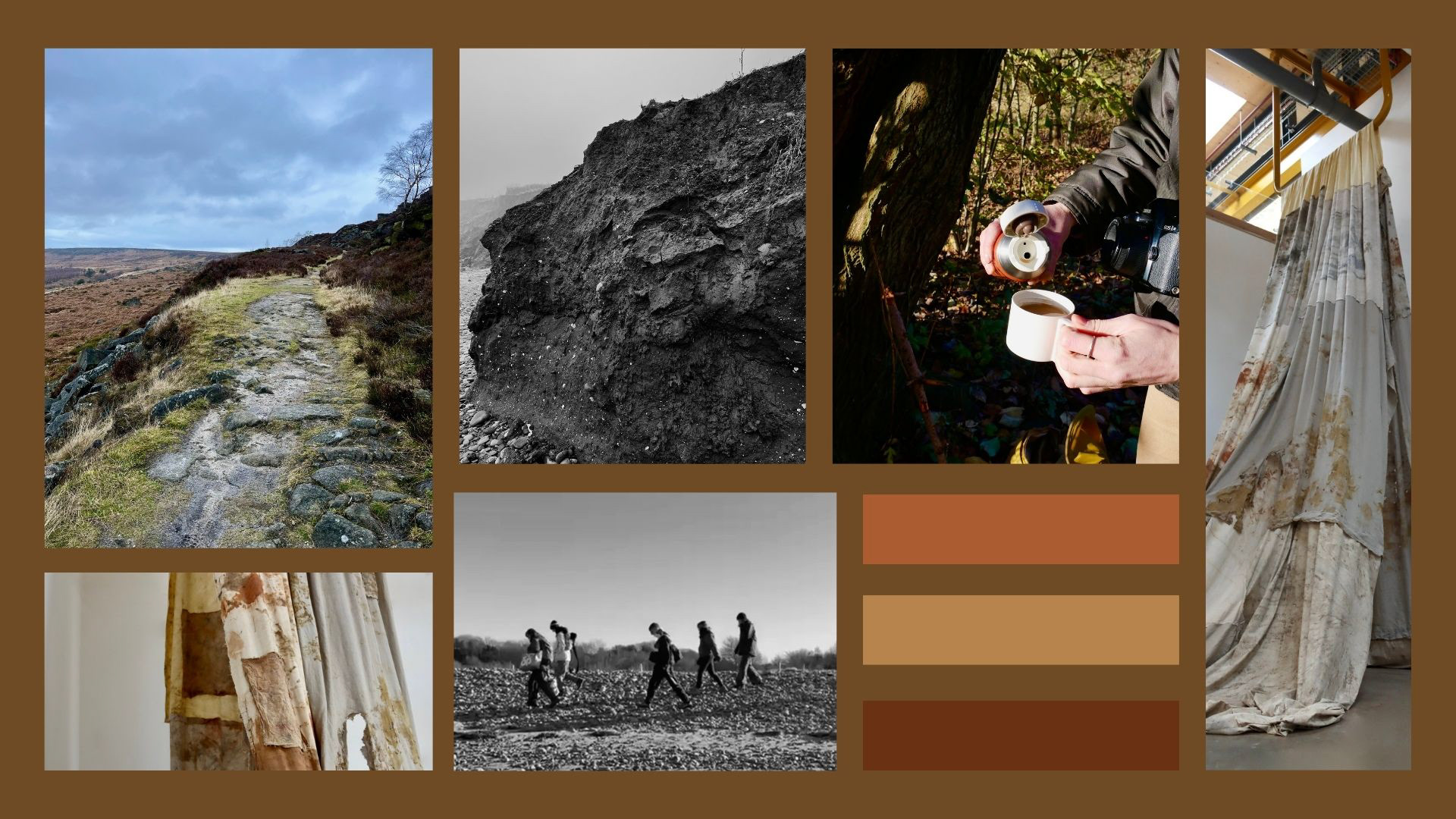
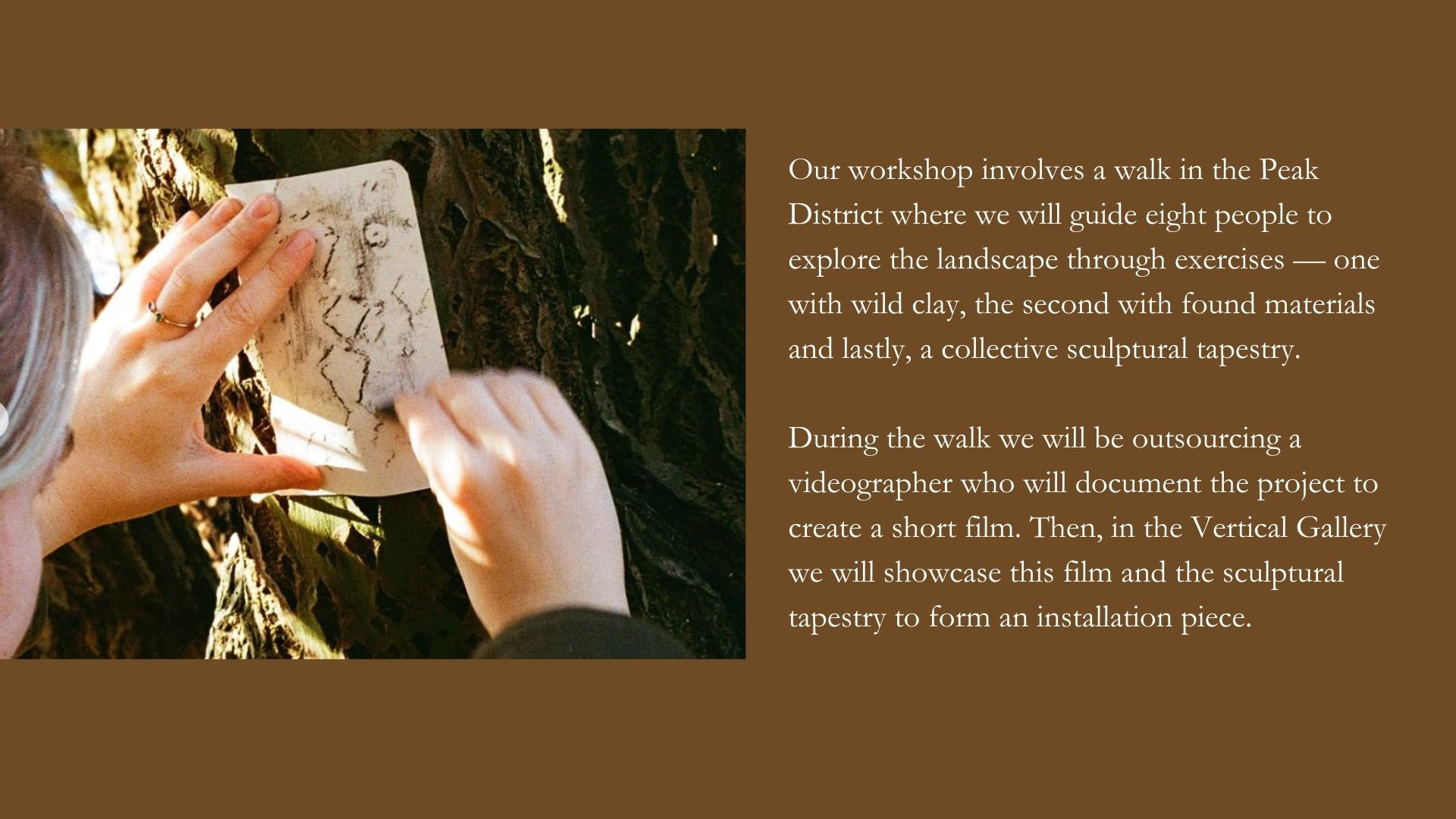
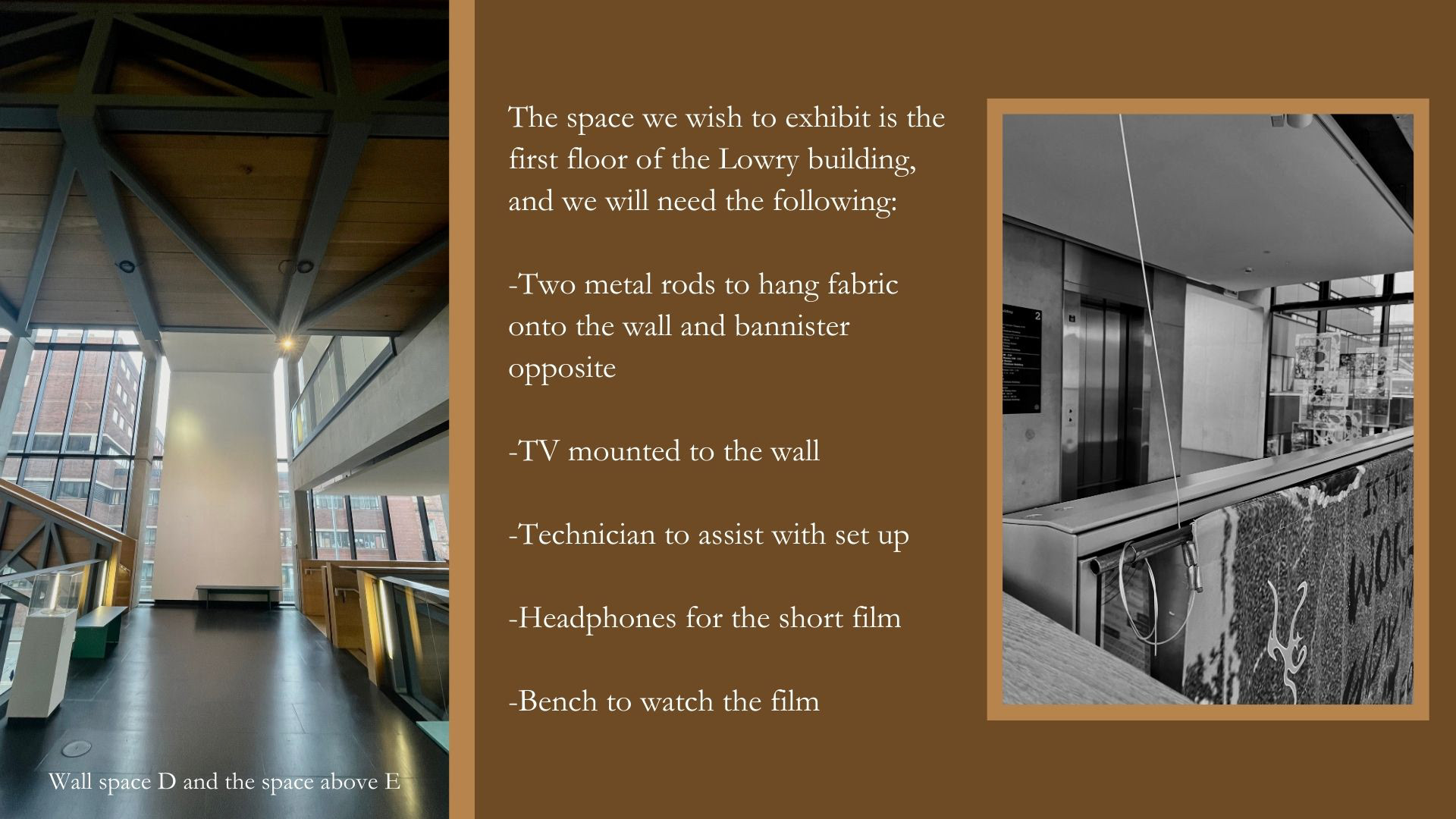

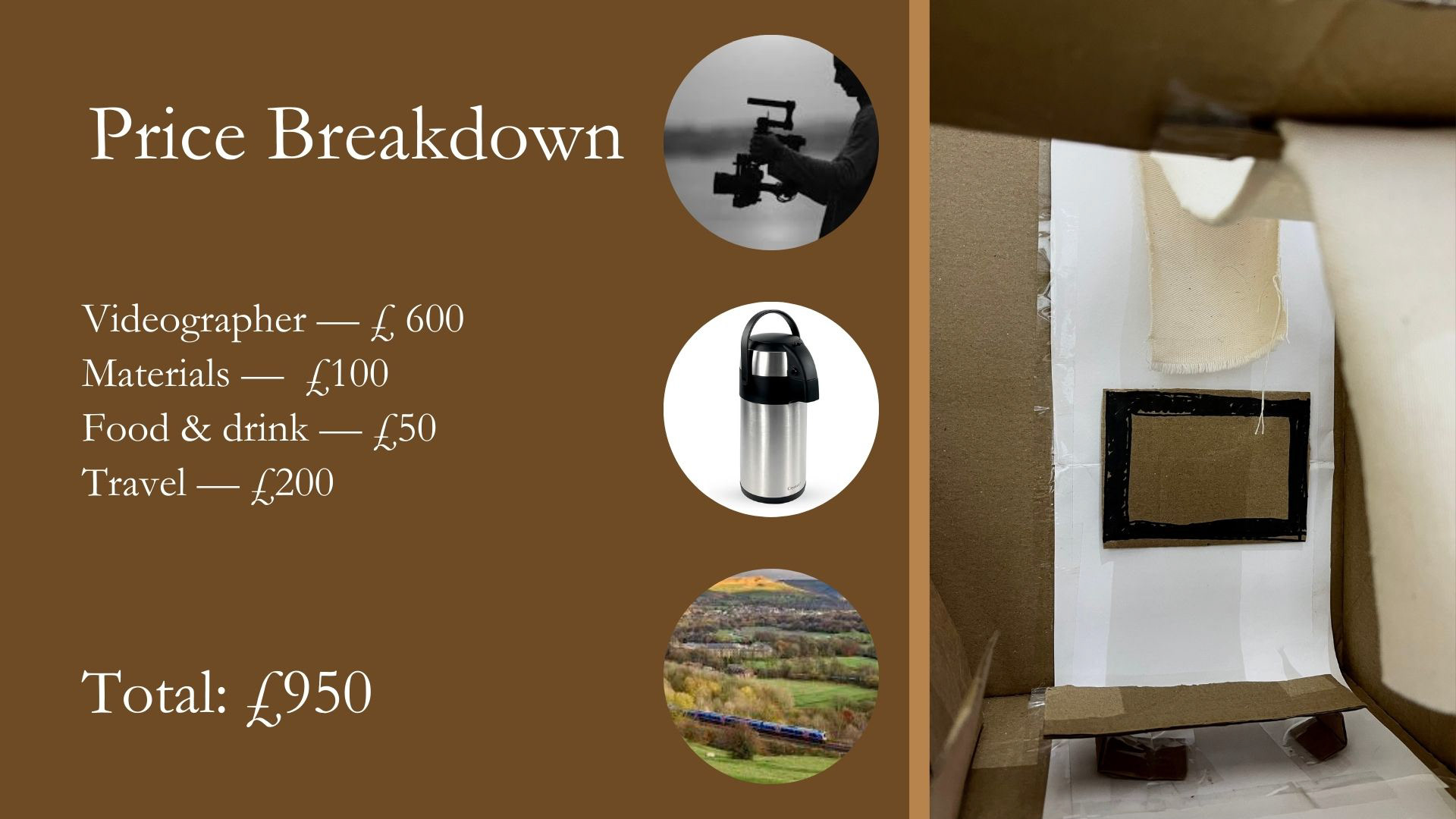

First Steering Meeting
After finding out that we had been successful in our pitch and had been shortlisted, we were emailed saying that the tutors leading the commission would like to invite another student to join our team and proposed that we create a cohesive installation on the third floor of the Lowry building. This was exciting news; however, it left us feeling quite apprehensive because the project will most likely change quite a bit.
All the successful applicants met to discuss which spaces we would have for the exhibition. This allowed Abbie and me to meet our third collaborator, Joab, a final-year graphics student. We had all proposed an exploration of the Peak District and materiality, and Joab's project was to present his findings through film. Collaborating with a filmmaker reduces our budget. However, changing the installation location will change the project's direction.
This, therefore, means that we will no longer be creating printed draped fabric work, as inspired by Edie Evans. The new space wouldn't be suitable for this style of hanging fabric, and as we are now working over more disciplines, we will be using fabric more immersively.
Burbage South, Peak District
Abbie and I went into the Peak District to gather inspiration and thoughts from the landscape. We went to Burbage, the location I am working on for my project on the millstones. We brought a bag of clay to start working with and some fabric to think about how we would use the fabric in the workshops.
The clay slip, which is gathered from the caves also in the Peak District, was fairly hard to work with on the fabric, so we will need to work out how it is best to apply clay onto the fabric and whether different fabrics will work better for the clay to stick onto.
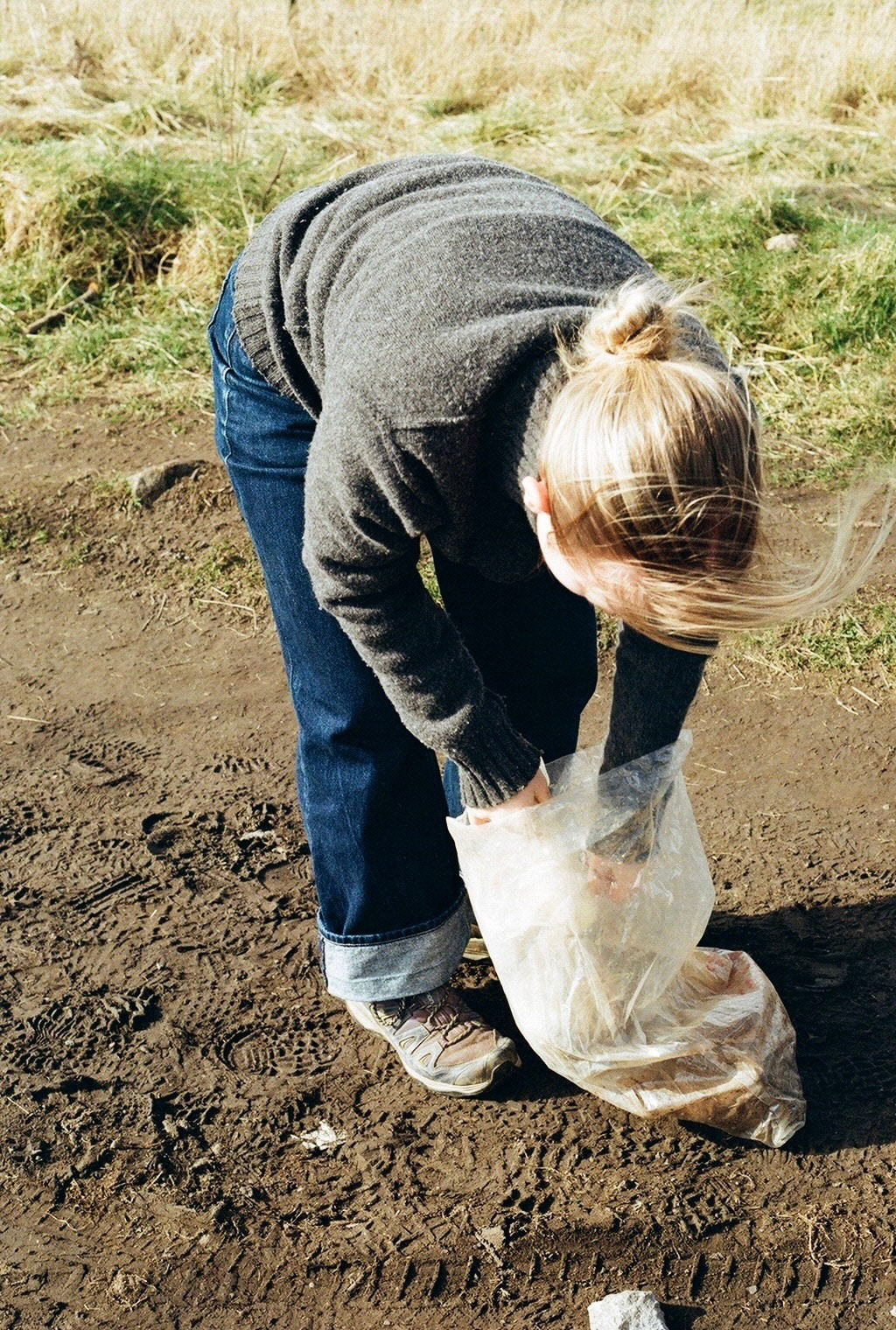
Photo credit: Abbie Fowler
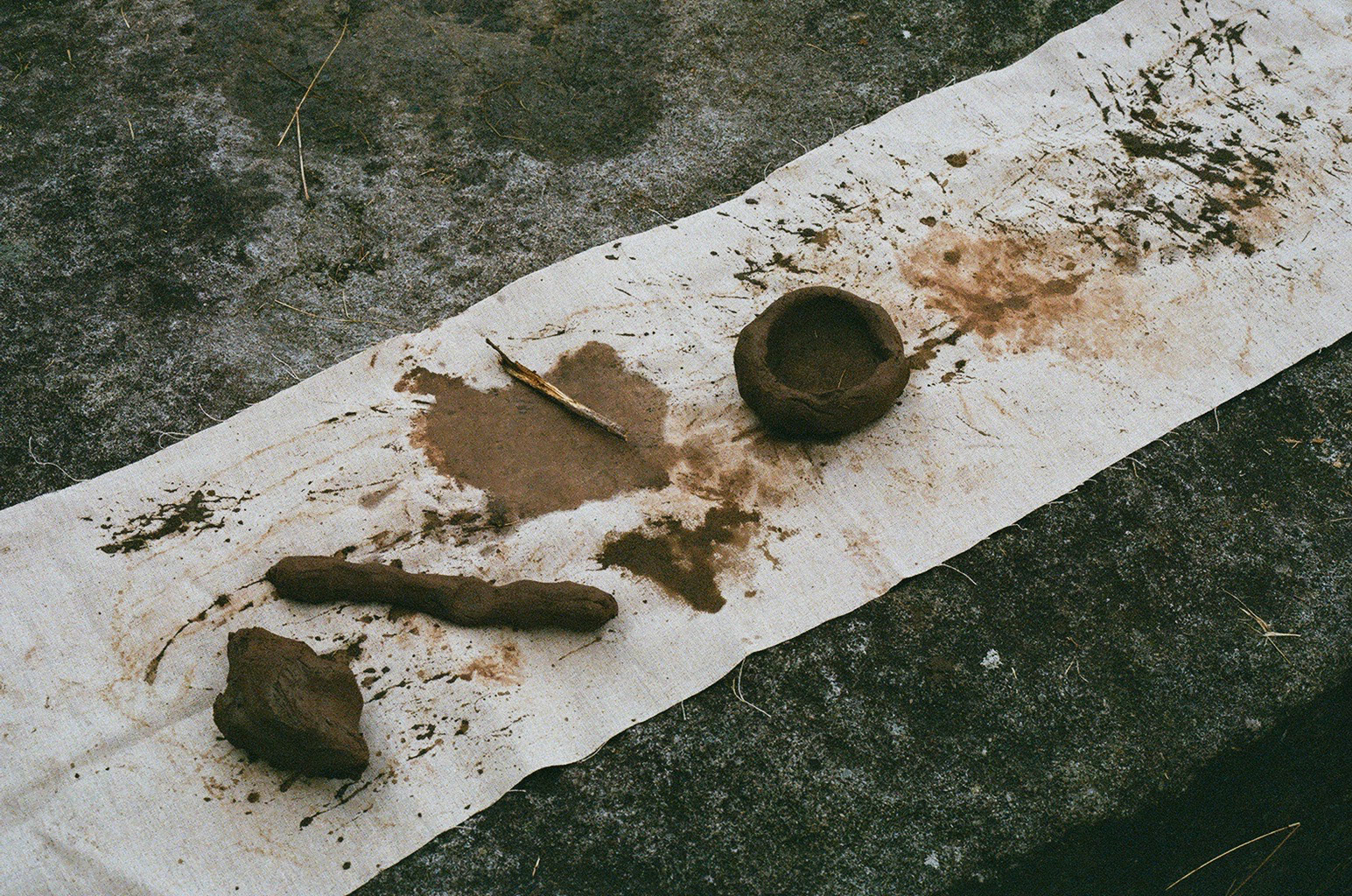
Photo credit: Abbie Fowler

Photo credit: Abbie Fowler
Change of location
On the 4th of March, the three of us met with Kate and Victoria, as they had some news for us regarding the location of our Vertical Gallery commission. We were told that, because Architecture students now have their degree show in the third-floor space of the Lowry building, we were being moved to the Holden Gallery. This was exciting news for us, as it broadened our ideas and the space we had to work with. The space is a better fit for our proposal and vision of what we aim to create for the installation. However, the location change meant we had to rethink the installation because the space was much bigger than the original plan.
We were informed that there would be a possibility of altering our budget, as the changes in the space and having more freedom with what's on offer might mean that we need to have a bigger budget.

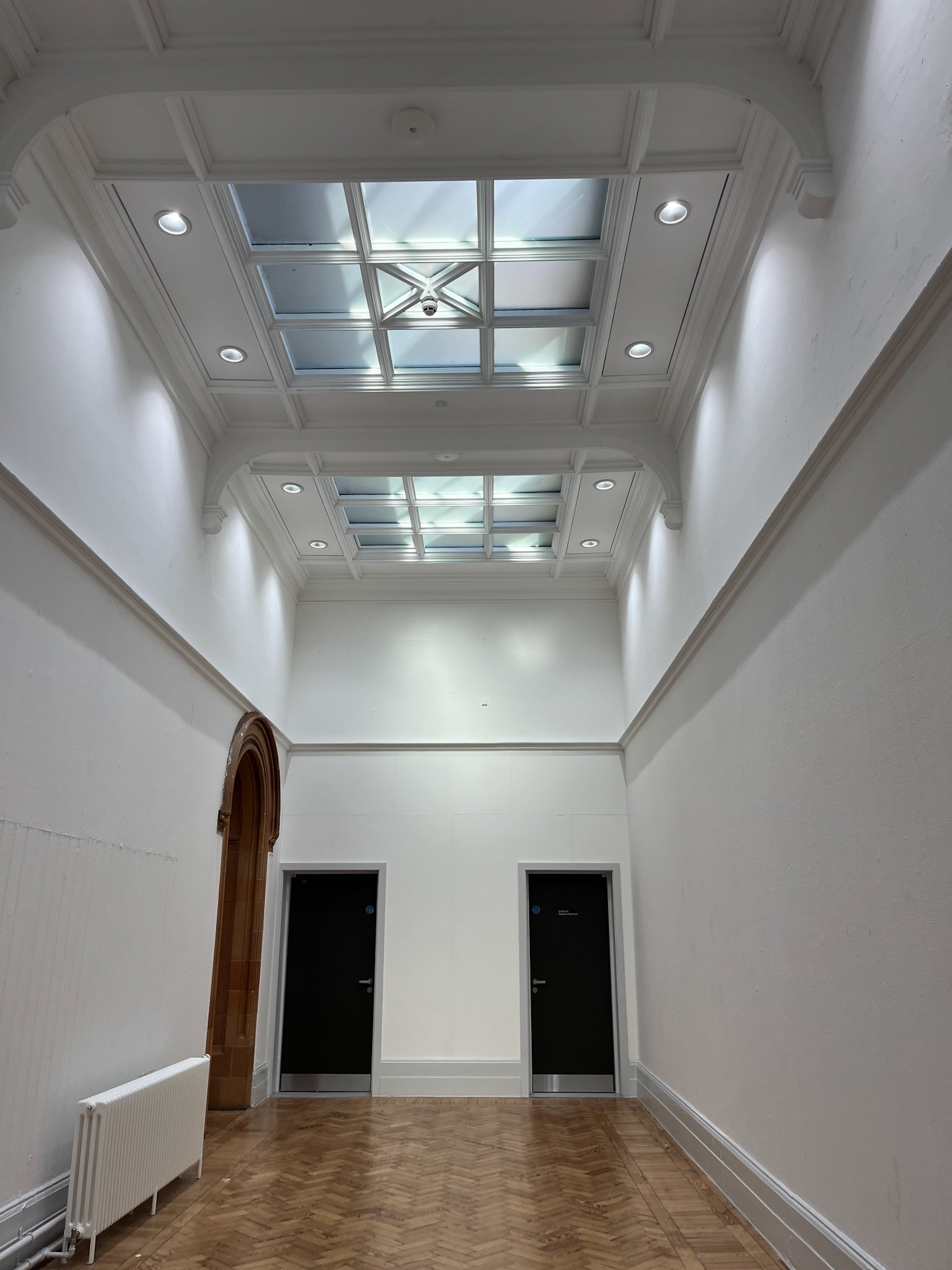
The location change has meant that we have had to rethink our proposal for the exhibition. The old space, in the corridor of the third floor of the Lowry, was very contained and narrow, which meant that it was hard for us to think about how we would be able to install the ideas in the space.
Now, we have much more wall space and extra height, which gives us much more to work with. Abbie, Joab and I met after we met with Kate and Victoria to discuss new ideas and how we all see the project looking and moving forward.
New ideas
We have decided to move away from the idea of leading a public community workshop for this project. We are working on a more significant collaborative project with graphics student Joab and developing many more ideas by combining all three projects. We have decided to focus more on our strengths as makers, bringing our ideas into one project. The workshop idea would not fit in the exhibition space as well as we initially thought, as working together with Joab, we have decided to focus on making for the space curation.
The curation from the Soil exhibition was invaluable to our decisions about what we propose for our work. We envision creating an enclosed, cavernous environment, one in which the viewer can enter and interact with. The installation space holds as much importance as the making, for how we curate the space is the catalyst of our project.
Installation Plan
To organise our time between the three of us, we have dedicated tasks for each of us to complete due to having to repropose and think about this new space of exhibiting. We needed to email the Vertical Gallery technician with technical questions about our proposal, as we were unsure whether it would be possible to hang the hangings in the new space. We must also research costs due to possible budget changes and new ideas. We are also thinking about a sort of leaflet/map that will allow visitors something to take away with them but also give them more information about the installation.
Joab has made a mock-up of the installation space, showing inspiration for what we envision and the structure of the space with what we have to work with.
Floor plan of Holden Gallery
I've highlighted our installation space. This is an old floorplan, before the renovations.
Cad drawings
I have used Rhino to understand better how we expect the large millstone structure to look. This is scaled to real size: diameter 183cm, central hole diameter 33cm, thickness 40cm.
I have made this as we want to replicate a millstone for our installation. This, therefore, links my project to this project, allowing them to have a direct overlap. By making a large-scale millstone displayed in the centre of our installation, we are bringing the Peak District to the exhibition space. This is also what I am aiming to do with my degree show, as I believe bringing this environment into the space of a gallery is an important way to reflect on the natural earth and how key landmarks in a specific area are perceived when they are taken out of their natural landscape.
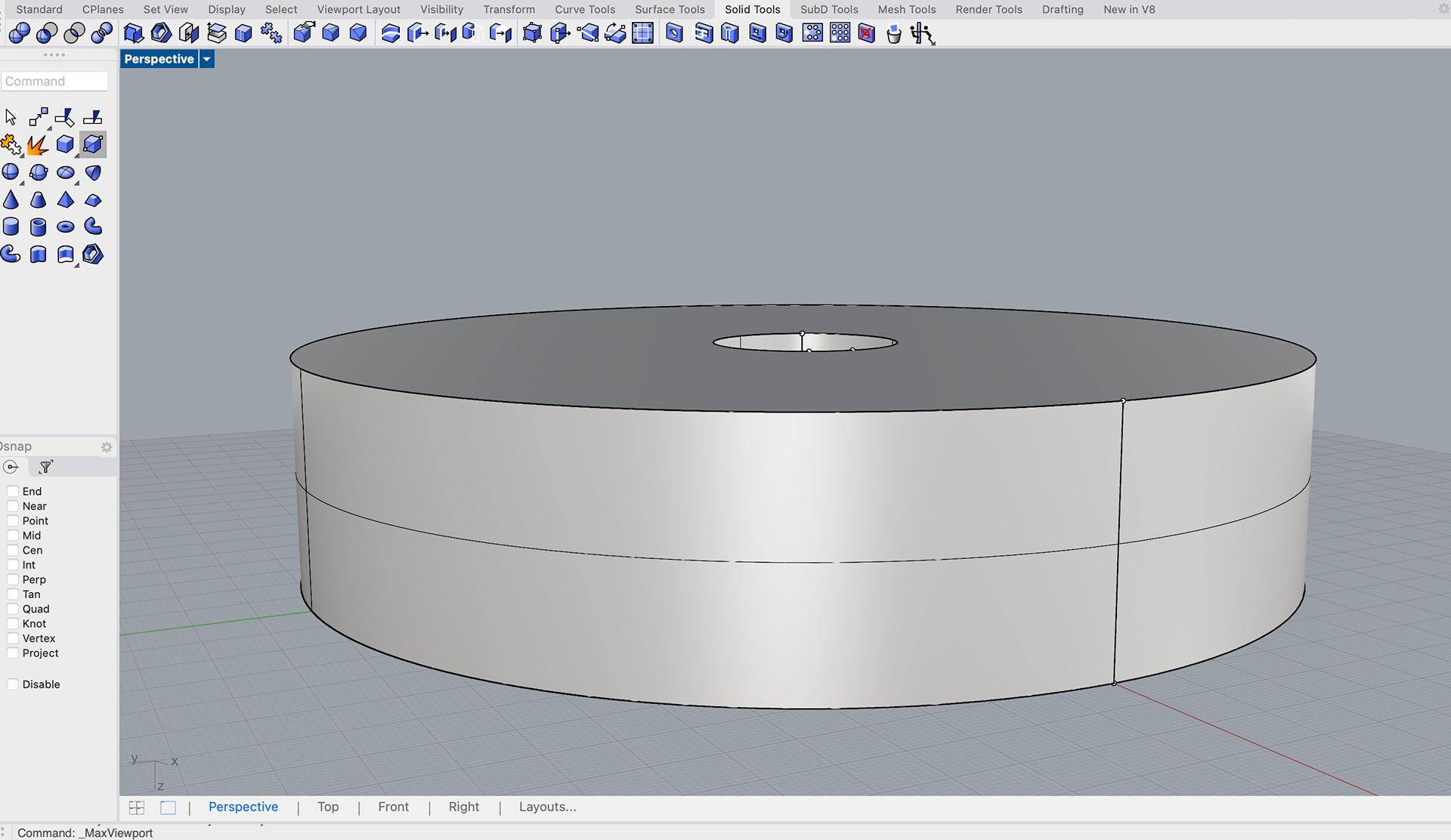
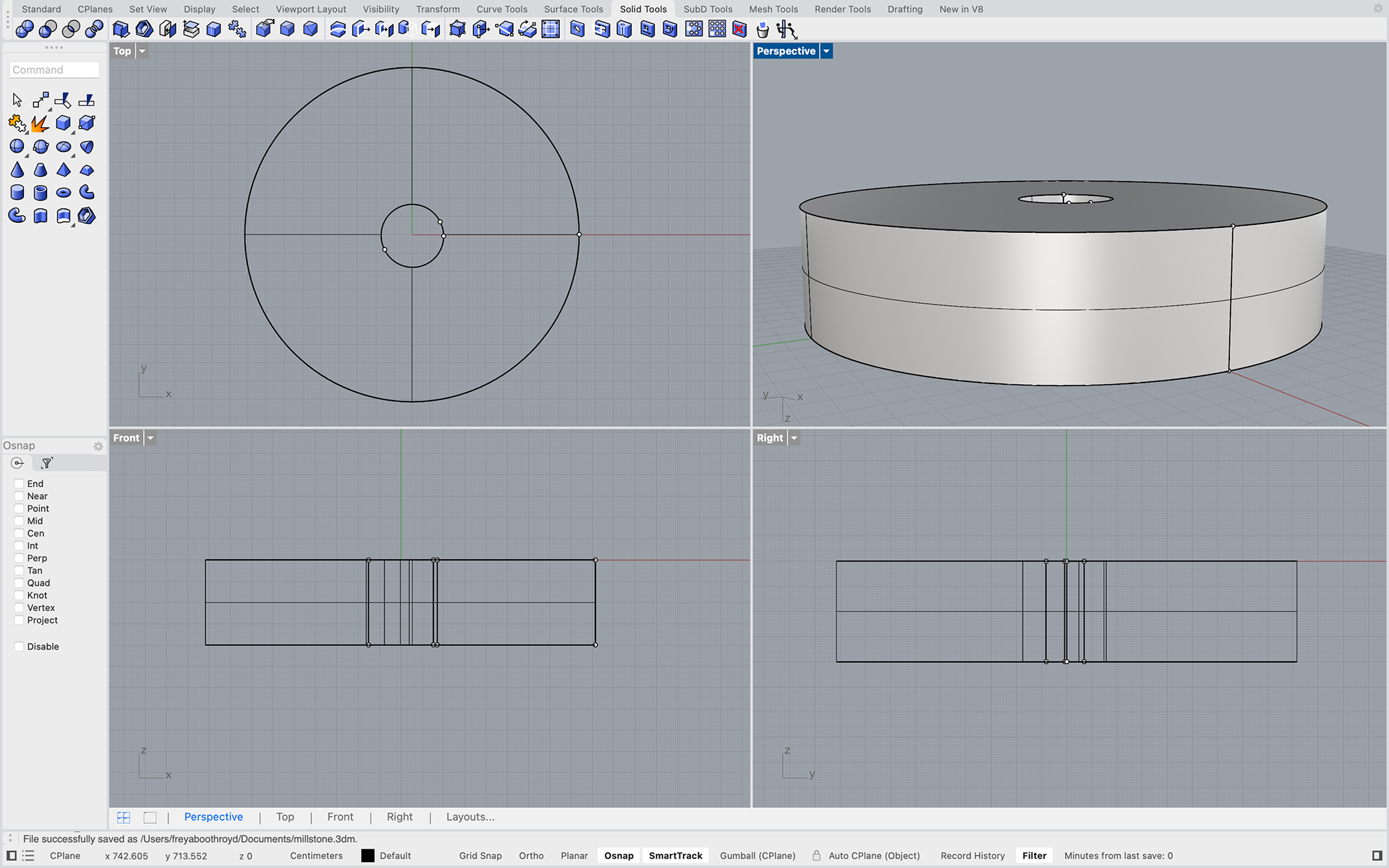
We aim to recreate this millstone by creating a structure using plaster or wood. We would like to bring as much clay or natural resources as possible to this, as this is what our project revolves around; however, we also need to consider the sizing of the object.
After we met with Kate and Victoria on the 18th of March, they recommended that we be less literal with our making. Instead of trying to recreate a large-scale millstone, the materiality of the Peak District should take the lead. The more in-depth, ephemeral qualities we pick up on during our visits to the area and how these influence us to make within the land.
I aim to merge my Synthesis and Resolution into the making I will create for Common Ground. I want to simultaneously bring my material voice into both projects, allowing each to reflect the other. Producing the same way I make for S&R, using the same materials and intentions, will provide continuity in each body of work.
I continue to build the slabs I am producing for Synthesis and Resolution. This will be included in the installation for Vertical Gallery. However, our plan for the Vertical Gallery project is to have various material findings taken from inspiration from two areas of the Peak District.
White Peak/ Dark Peak
Our intention with this project, which we found through our continuous development and idea generation during visits to the Peak District and group studio days, is to focus on the contrasting areas of the White Peak and the Dark Peak.
The White Peak and Dark Peak have very contrasting landscapes and geographies, with the White being made up of limestone and vast glacial dales, compared to the Dark Peak, which is known for gritstone, dramatic edges and rough, wild moorland.
The White Peak has a grey, lighter colouring due to the limestone and many standing stone circles. These are associated with pagan ceremonies and are rich in folklore. There are around 25 stone circles in the Peak, and these ceremonial landscapes have been used in rituals for centuries and have a very rich heritage.
Bournemouth University. “3,700-Year-Old Stone Circle Discovered in Derbyshire Forest | Bournemouth University.” Bournemouth.ac.uk, 2025, www.bournemouth.ac.uk/news/2025-03-24/3700-year-old-stone-circle-discovered-derbyshire-forest. Accessed 6 Apr. 2025.
The Dark Peak is where the gritstone millstones are found. This area takes up more of the Peak District's mass area and has a bed of gritstone covering the limestone underneath. It has dark, red soils and stones formed through the rock's iron quantities. The millstones formed here were made in the quarries of the Dark Peak, which were formed from the excavated rock of the hillsides.
Tucker, Gordon. “Millstone Making in the Peak District: The Quarries and Technologies.” Gordon Tucker: Derbyshire Peak District Millstones, 1985, www.outsideecho.com/DGT-BIO_files/PDFs/DGT89.pdf. Accessed 6 Apr. 2025.
Map of the White and Dark Peak. Mathews, Dave.
“Visiting from Overseas? Try Rock Climbing in the Peak District?” Aspireadventureactivities.co.uk, 12 Jan. 2019, aspireadventureactivities.co.uk/try-rock-climbing-peak-district/. Accessed 6 Apr. 2025.
Within each site, although we are looking at the areas as a whole, we are narrowing down to Arbor Low in the White Peak and Burbage Quarries in the Dark Peak. Arbor Low is a significant site of the White Peak and is classed as the "most important prehistoric site of the East Midlands" (English Heritage). Burbage Quarries, however, is an area rich in Millstones and dark gritstone.
For the project Common Ground, we will uncover more about these two distinctive areas, looking at their opposing natures and qualities. We will compare the two sites, looking into the historic millstones of the Dark Peak and the mystical natures of the stone circles in the White Peak.
Even though the three of us as collaborators are working simultaneously and equally on the project as a whole, with each member of the group working together on each step, all with the same intentions and amount of idea generations, we are ensuring that each of us has our separate roles in this project, to ensure clarity of each of our disciplines.
As a Craftsperson and material-led designer, my role in this project is to gather more information on the material qualities of the two areas of the Peak District we are focussing on. Taking on board all the resources and information I have gathered throughout my project on the millstones, I am using this knowledge through my material gatherings for this project.
Using the clay I have sourced from the Caves of the Peak District, I, in collaboration with Abbie, am making clay sculptures inspired by the material findings we gather on the walks in the two opposing areas. These walks act as the workshops we intended to do at the very start of this project. However, instead of doing them as a larger group, Abbie, Joab and I, as collaborators on this project, are completing the workshops as part of our journeys to the areas we focus on.
Through the workshops, we gather materials, such as stones, sticks, and anything that grasps our interest on the walks of Arbor Low and Burbage Quarries. These material findings will be distinctive to the White and Dark Peak, and I am interested in surveying them and tracking their differences or similarities.
I aim to bring these findings through clay sculptures made on location, alongside the materials and soils picked up from the locations, back to the studio to inspect and work with for installation for the Vertical Gallery. The physical work in the space takes a conceptual lead; it is the nature and research of the locations of the Peak District that will form the sculptural installation that will be presented.
Below are a few inspirational photos of what we envision the materiality in the installation space taking form. These are just reference photos, and our installation, alongside photography and prints predominantly made by Abbie and film projection made by Joab, will allow our piece to take on a multi-media ode to our collective love of the Peak District and the two opposing locations that make the area what it is.
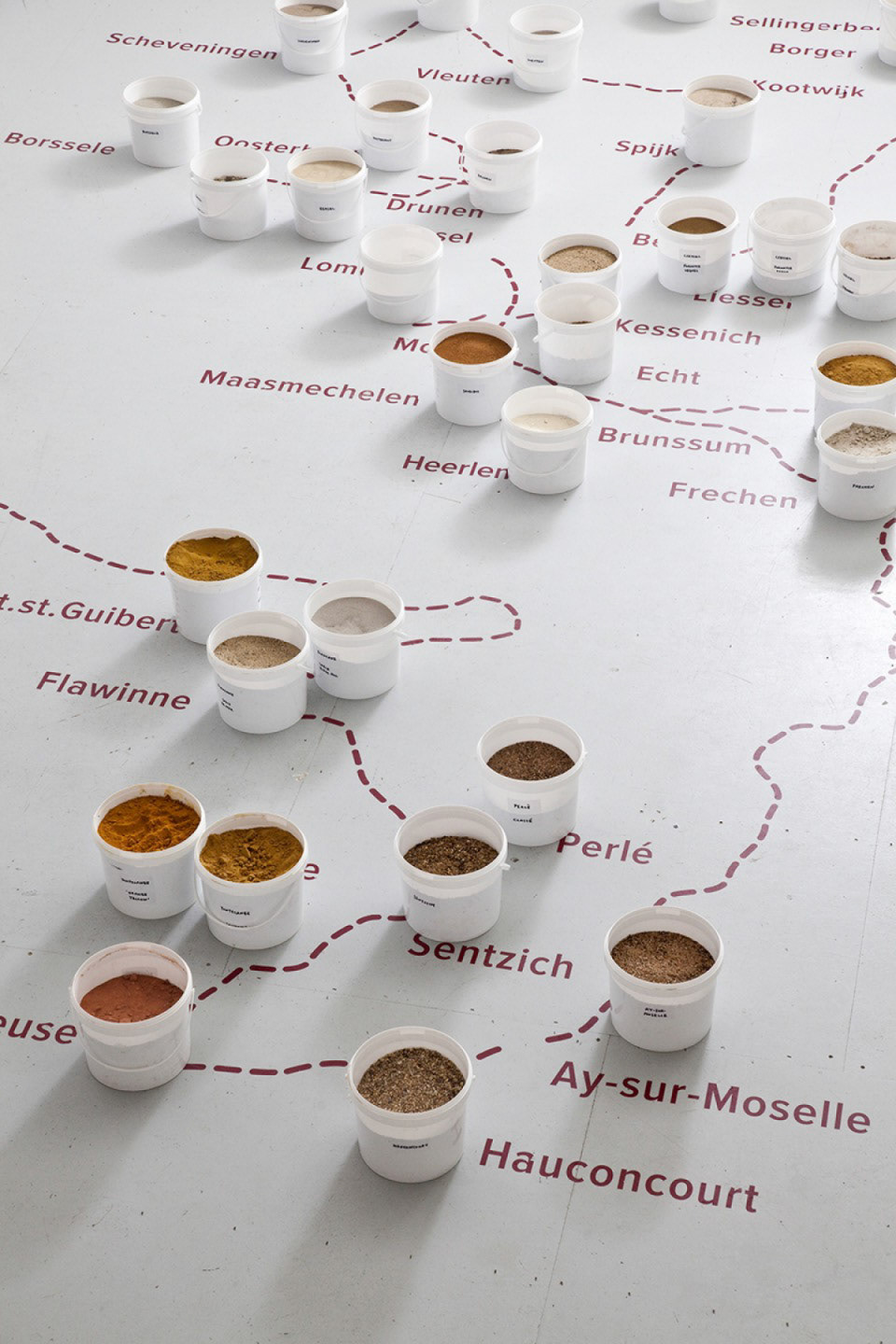
Atelier NL
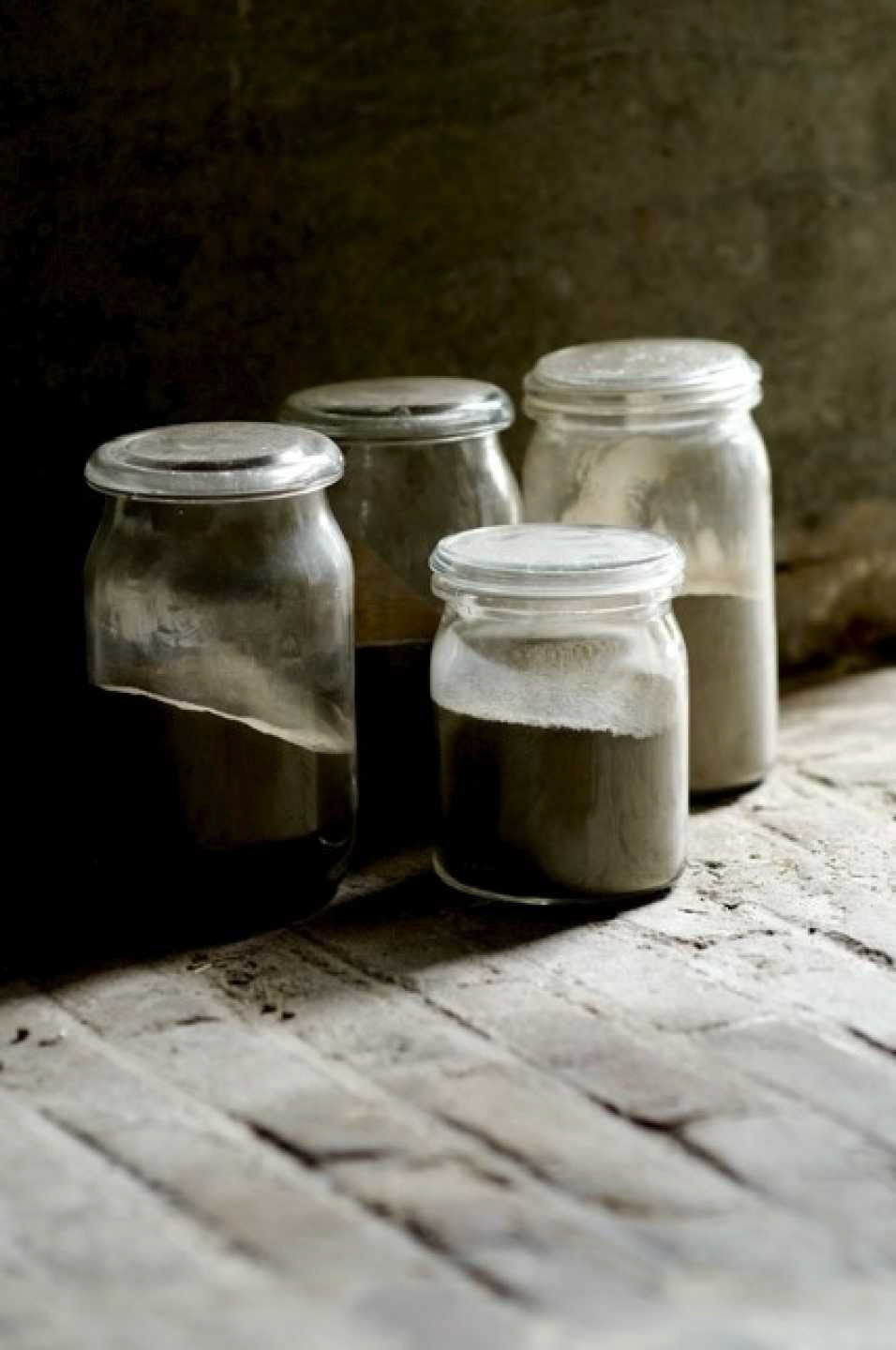
Atelier NL

Kim Norton
Projection trials
With one of the curtain fabrics that I ordered, Joab and I tested projecting a film onto the fabric. We discovered that the fabric we had ordered was too thin. However, the black fabric worked better than we originally thought. The fabric curtain will be across the length of the space and will be on both sides; therefore, we need to ensure we have enough of it; it is thick enough so the projection can be seen through it and that people can walk through it to enter the internal space where we will be showing the physical findings.
Burbage Quarry, Dark Peak
On a recent walk in the Peak District, the three of us went to Burbage Quarry. During this walk, we gathered material findings that resonated with us and that we thought represented the Dark Peak of this area. We collected them on a piece of fabric and replicated them through clay sculptures and drawings. These discoveries will be taken into the studio space, where we will examine them further and present our findings through an archaeological-style presentation. This style of curating our work for the installation works well for the style of our project, as I am investigating the materiality and histories of the landscape through material discoveries. Our findings, alongside the ceramic making inspired by these artefacts, make up the physical artwork in the space.
Photography by Abbie Fowler.

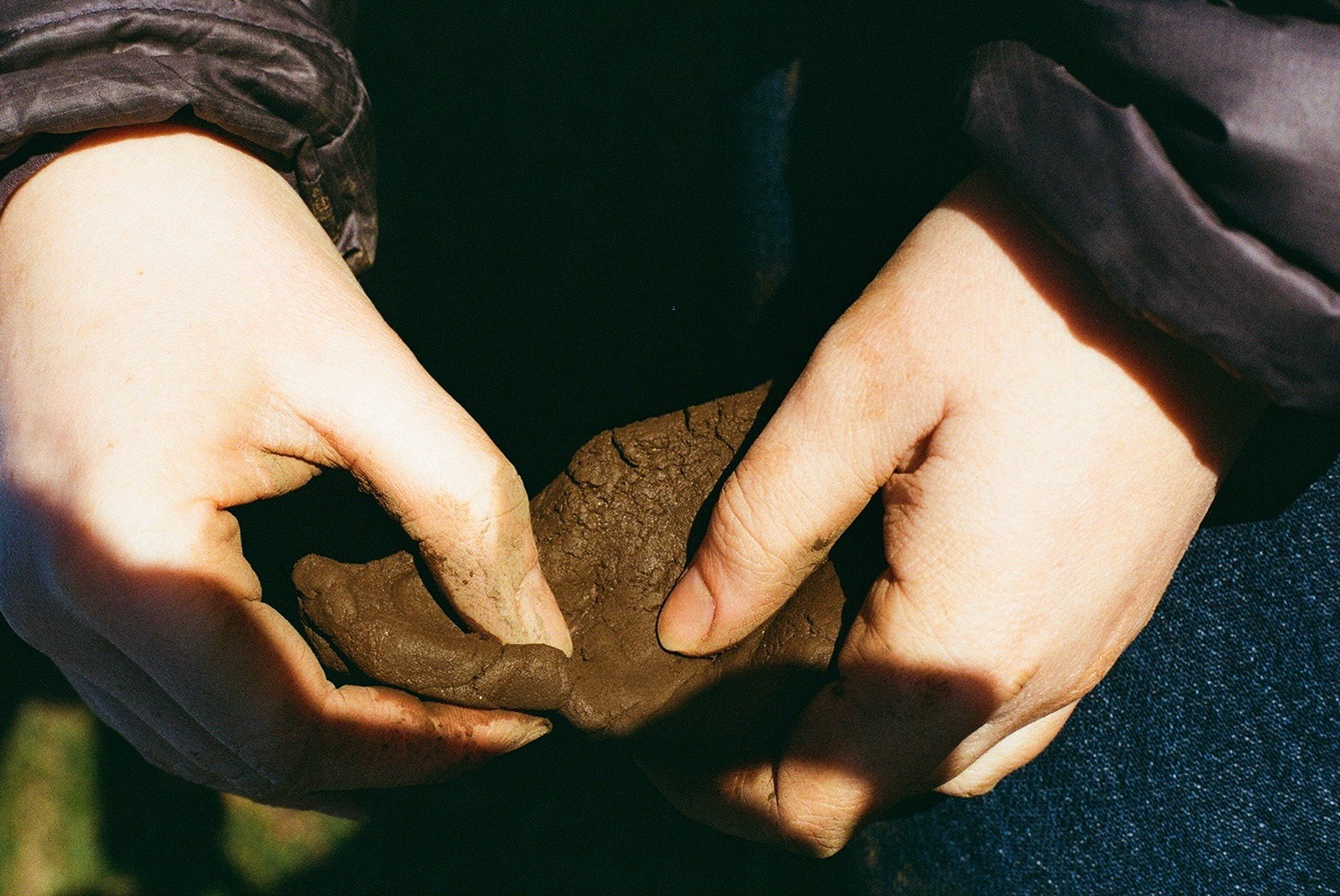
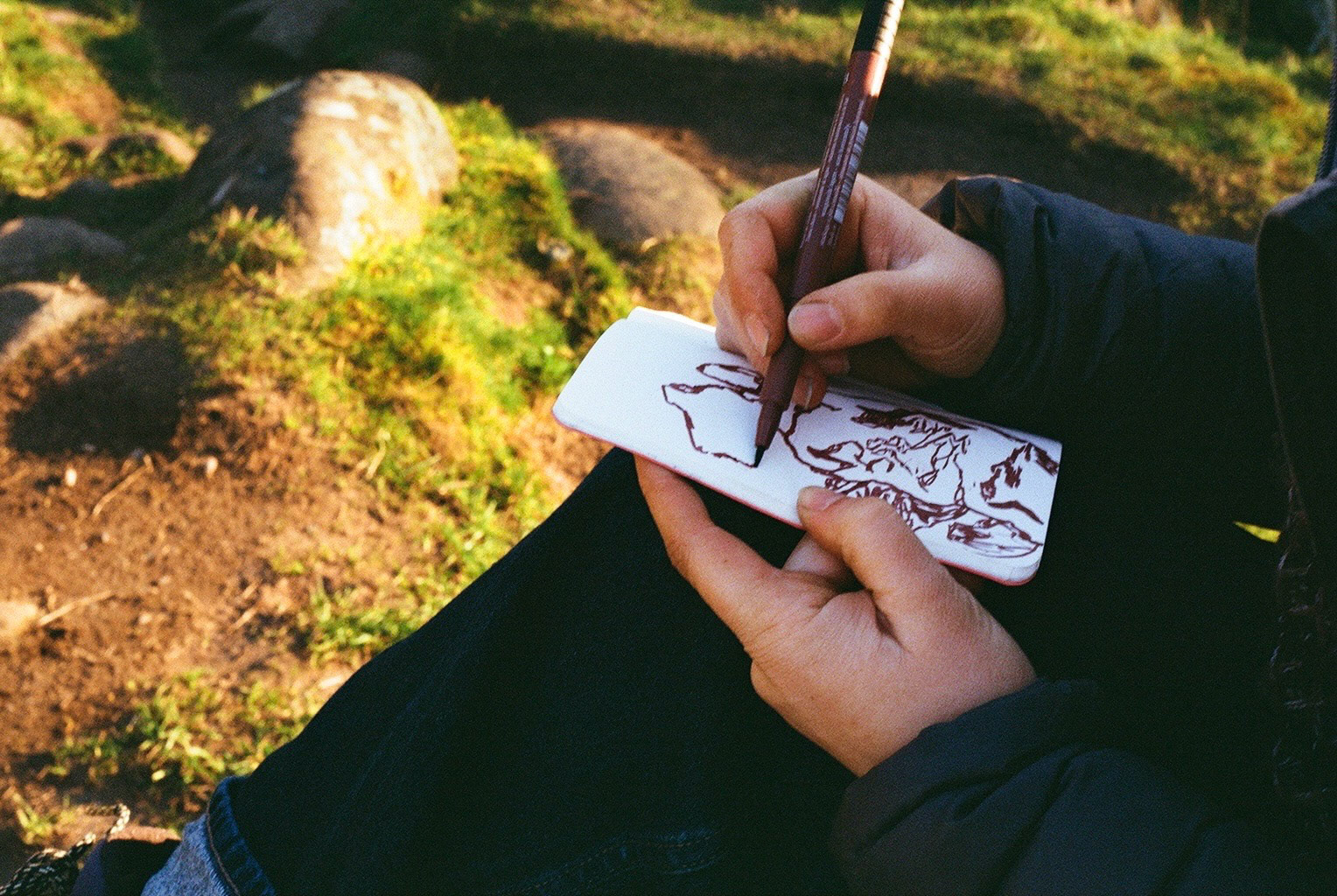
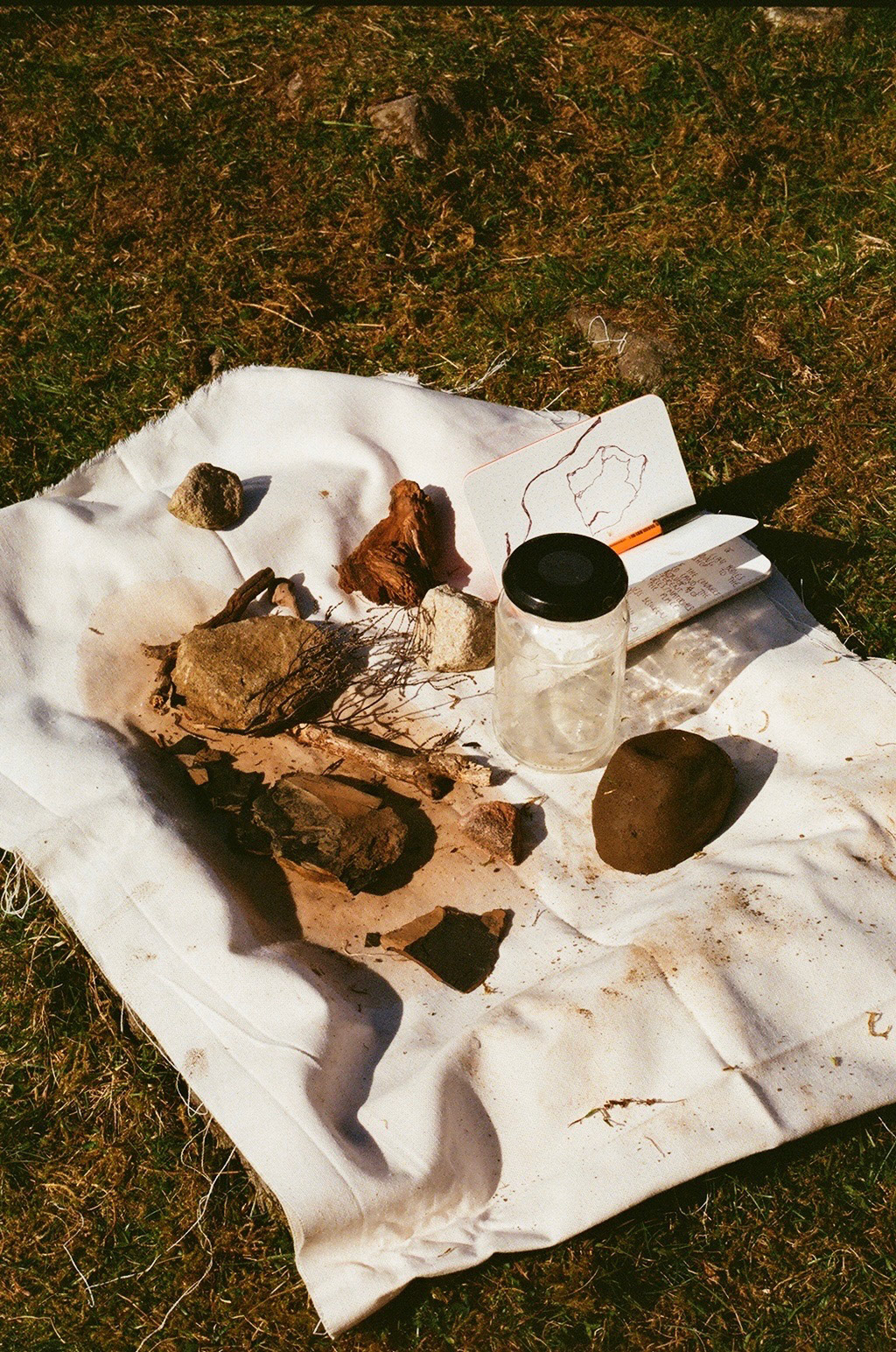
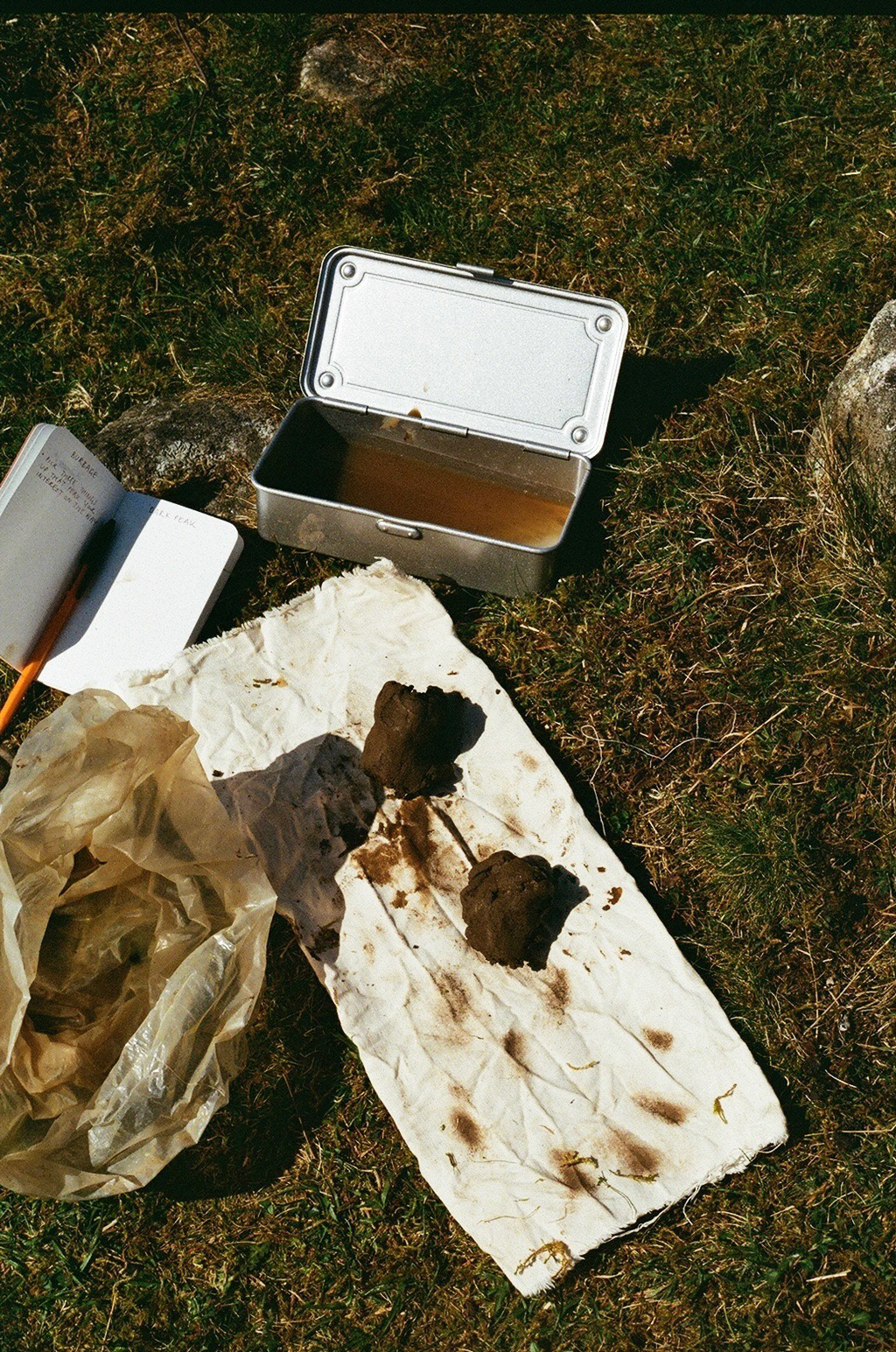
Arbor Low, white peak
The location that we are focusing on for the White Peak is Arbor Low. This area is rich in folklore, and it was very interesting to immerse ourselves in this unusual, mystic location that had such a huge contrast to the location we are focusing on in the Dark Peak. Arbor Low sits atop rolling hills of farmland, and its landscape is fairly barren and maintained. The limestone rocks of the fallen standing stones are protected by the mounds that have been made, creating a moat-like landscape within the field. I wanted to recreate these forms of the mounds and draw from them using clay. The clay is a physical representation of the landscape, enabling me to better understand the land's structure. The three of us collected material from the walk around this area; however, we found that compared to Burbage quarries, there were fewer artefacts to gather.



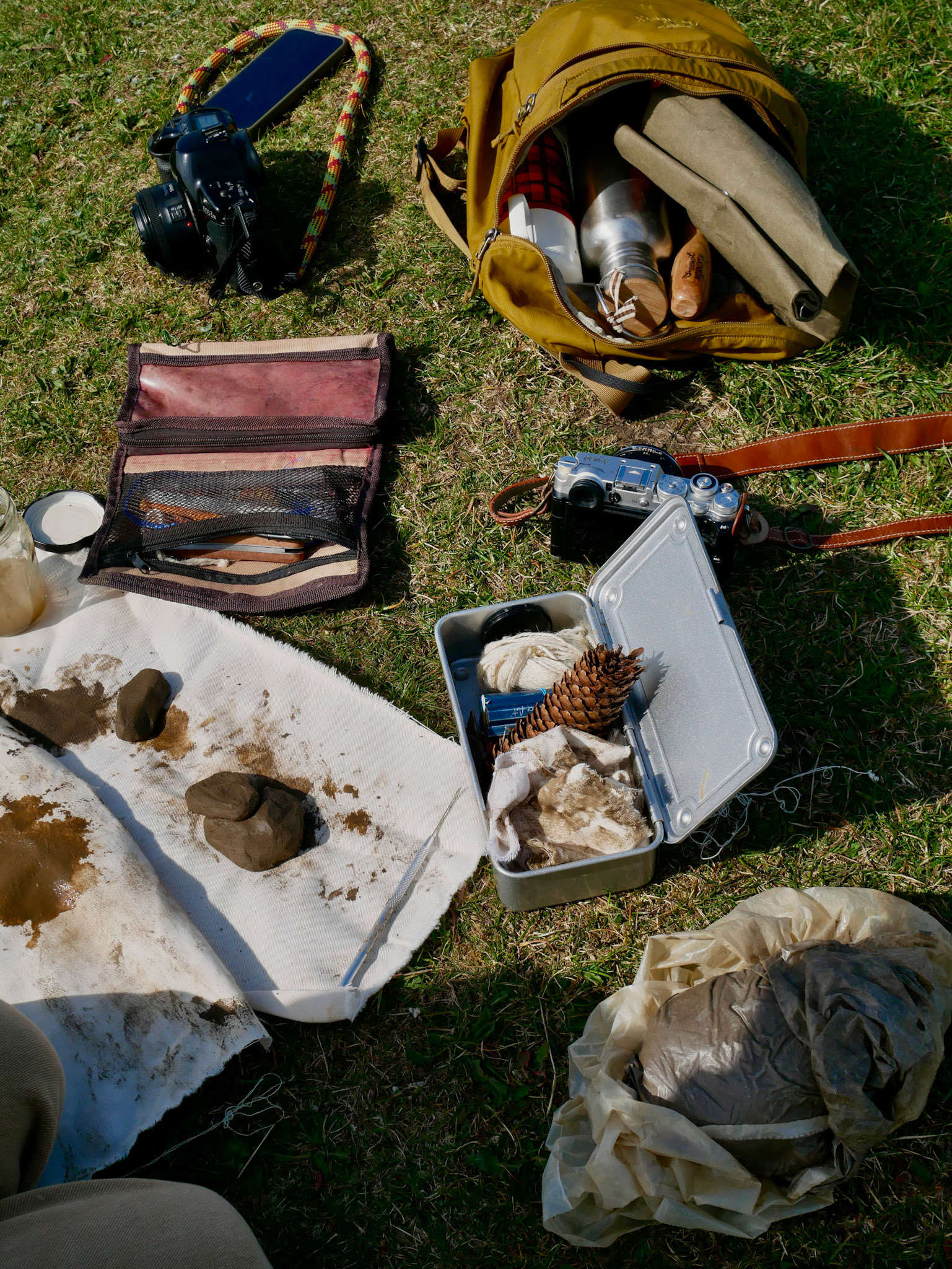
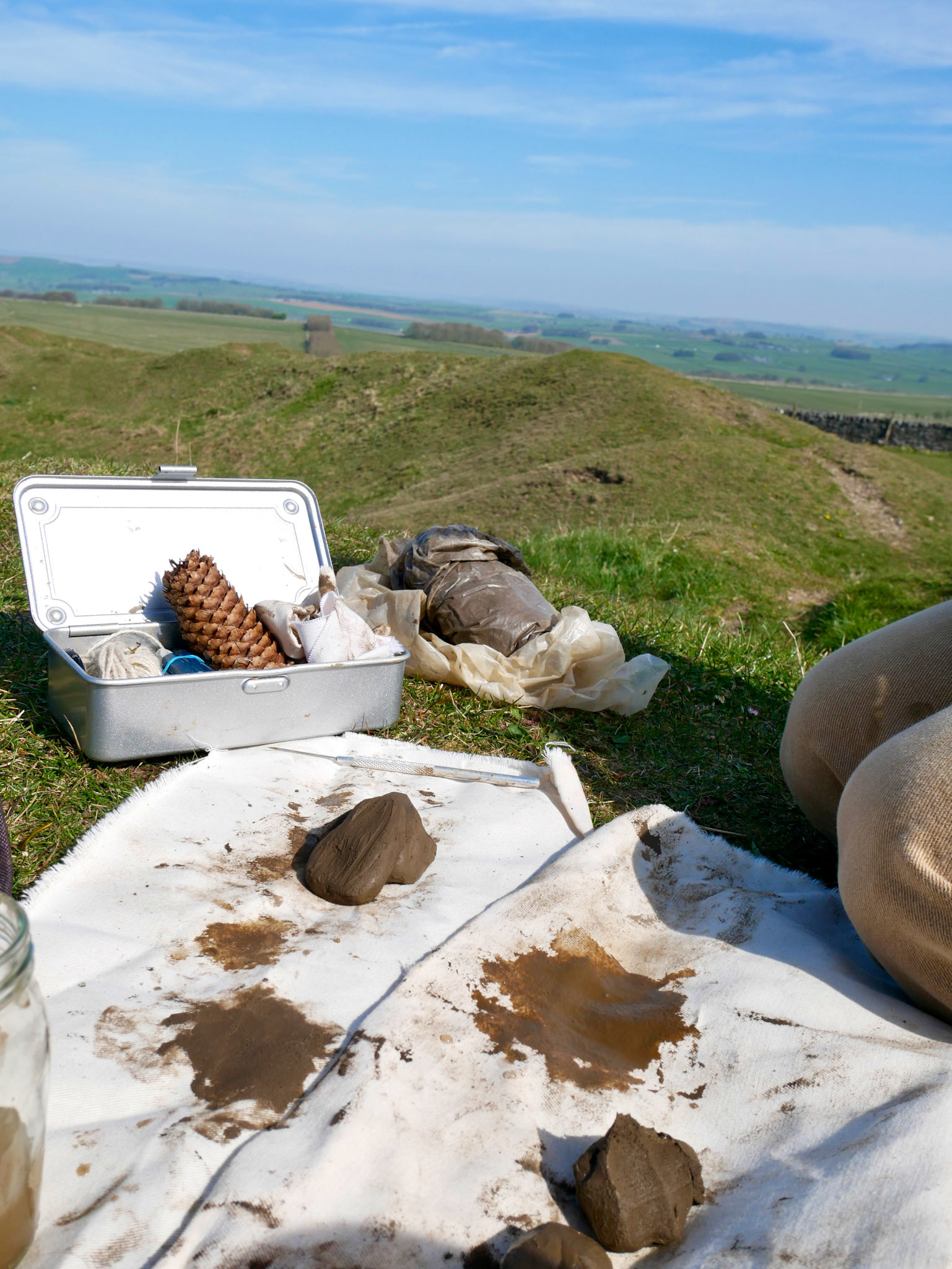
Communal Pot
On a recent residential trip to the Peak District, Abbie and I made a communal moon jar-style pot from the cave clay I had gathered. We made the pot on top of a large millstone in Burbage Quarries, the location of the Dark Peak we are working in. This pot will be a representation of the two Peaks, a communal offering to the land. By working together on creating one pot, making outdoors in unideal, harsh weather with strong winds and rain playing a part in creating this pot, the making became a ritual within the land.
With the gritstone I have collected from the White Peak and the Dark Peak, I will create a slip with both grits to apply onto the pot as a form of glaze. This will again highlight the contrasts between both landscapes and represent the dynamic changes of colour and textures through both areas.
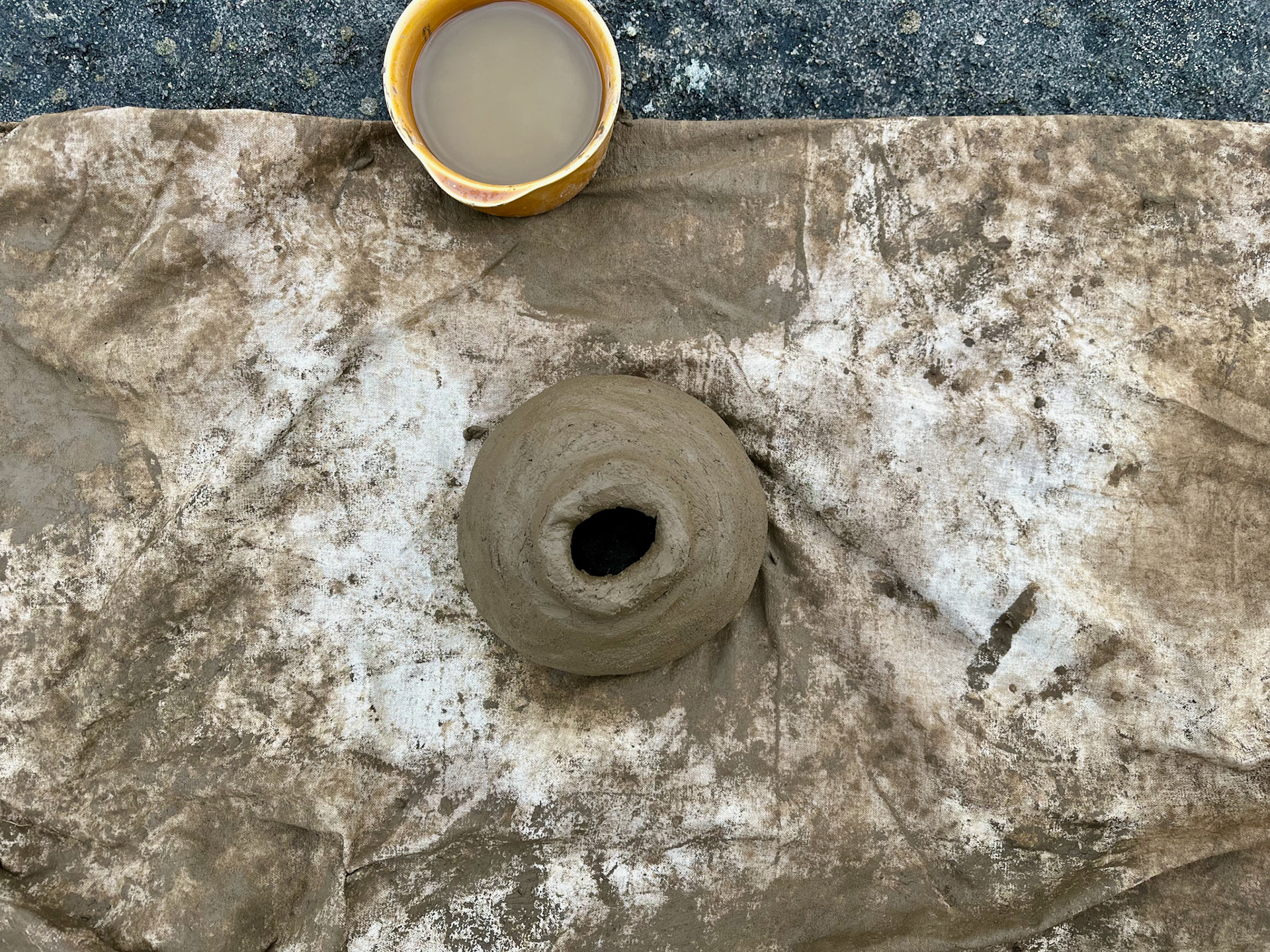


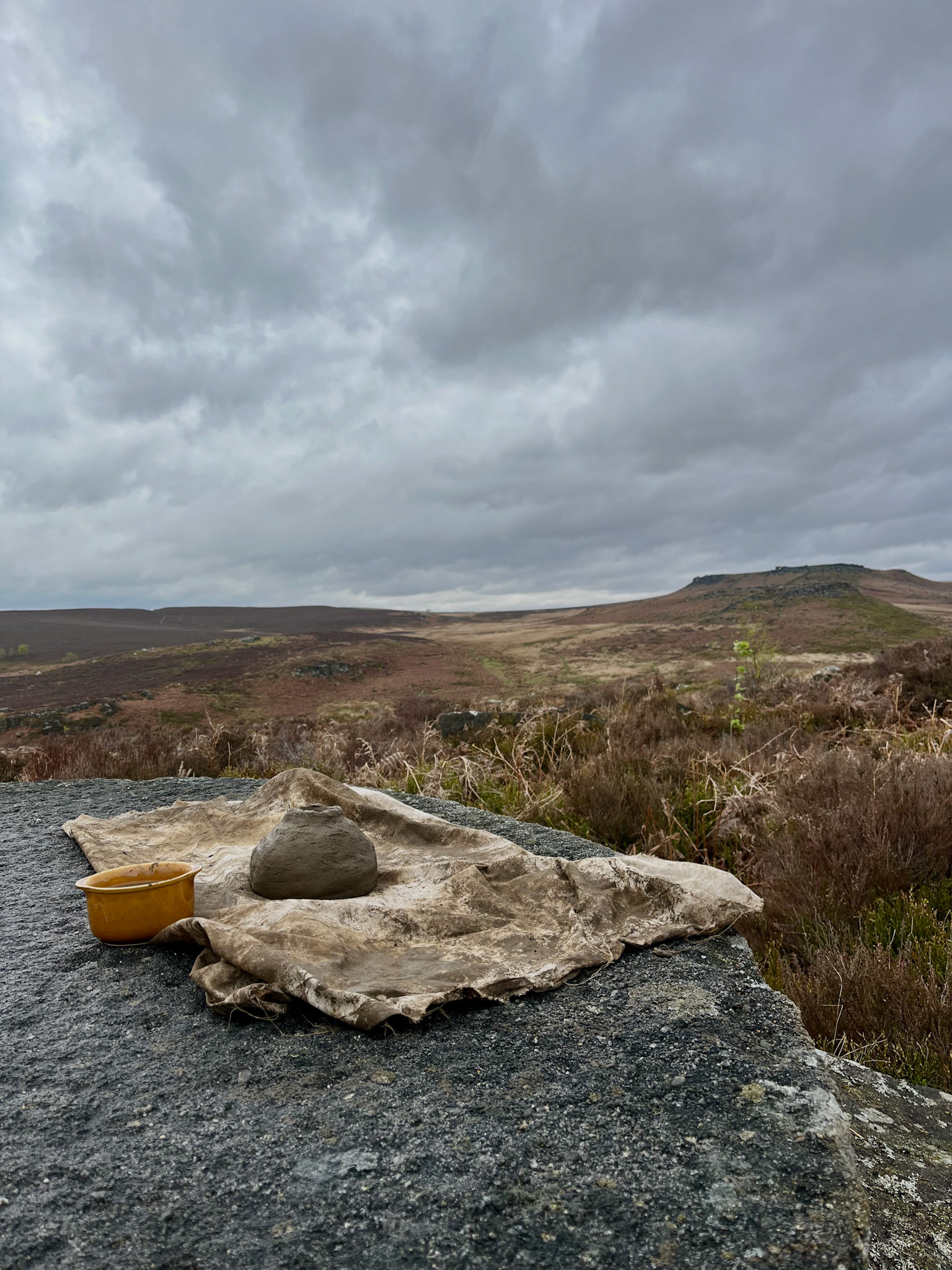
This time-lapse video shows the process of making the communal pot. We built them both using coils rolled out on the millstone, fully embracing all the natural elements that we were surrounded by. It was quite challenging making this due to the harsh weather conditions, but Abbie and I took it in turns to build up a layer of the pot each, ensuring that it was a fully collaborative, shared piece of work.
Working this way, as a collective with multiple hands working on the same outcome, has proven to be extremely rewarding and beneficial to my practice. The sense that craft should be communal and shared between people is one which I am very passionate about. Bringing multiple voices, hands, and viewpoints to the making of an object is a ritual that should be cherished and deeply respected.
Gritstone Glaze
On each of the two pots, I have applied a different stone glaze to represent the two areas of the Peak District on which this project is based. I have crushed the limestone rock in different amounts to apply onto one pot, both as part of a slip and also as chunkier pieces. For the other pot, I have applied stones which have been gathered in the caves as part of the clay digs, and also the grit stone from the dark peak. This gives the pot an earthy, more rugged look compared to the fairly controlled pot of the limestone. This, therefore, relates to the contrasts between the Dark and White Peak and the differences between each landscape.
I really enjoyed this process, as it felt more expressive and like I had more creative freedom with glazing these pots compared to the structured precision that I am working with in my parallel S&R project, From the Ground Up.

Crushing the limestone
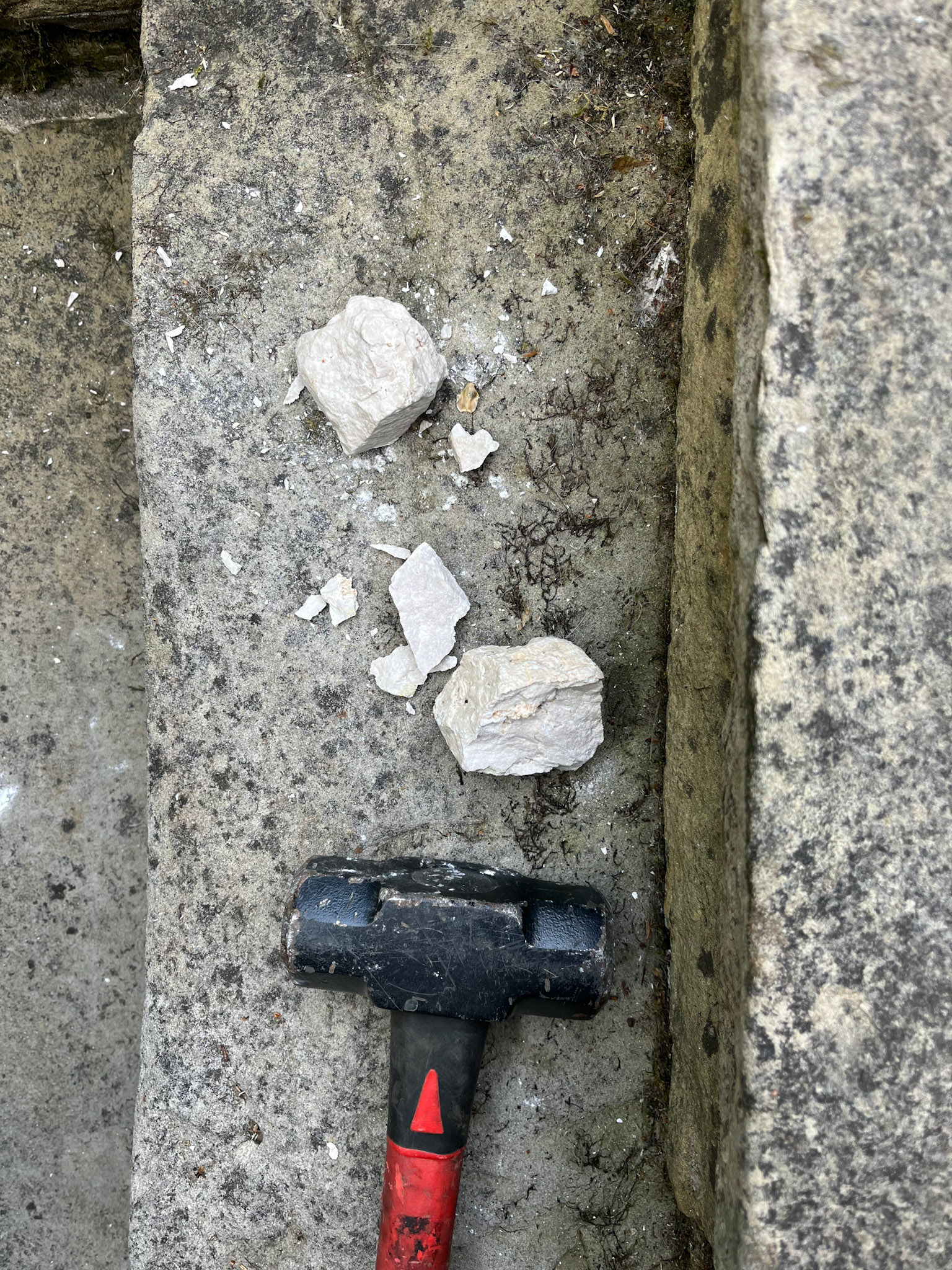
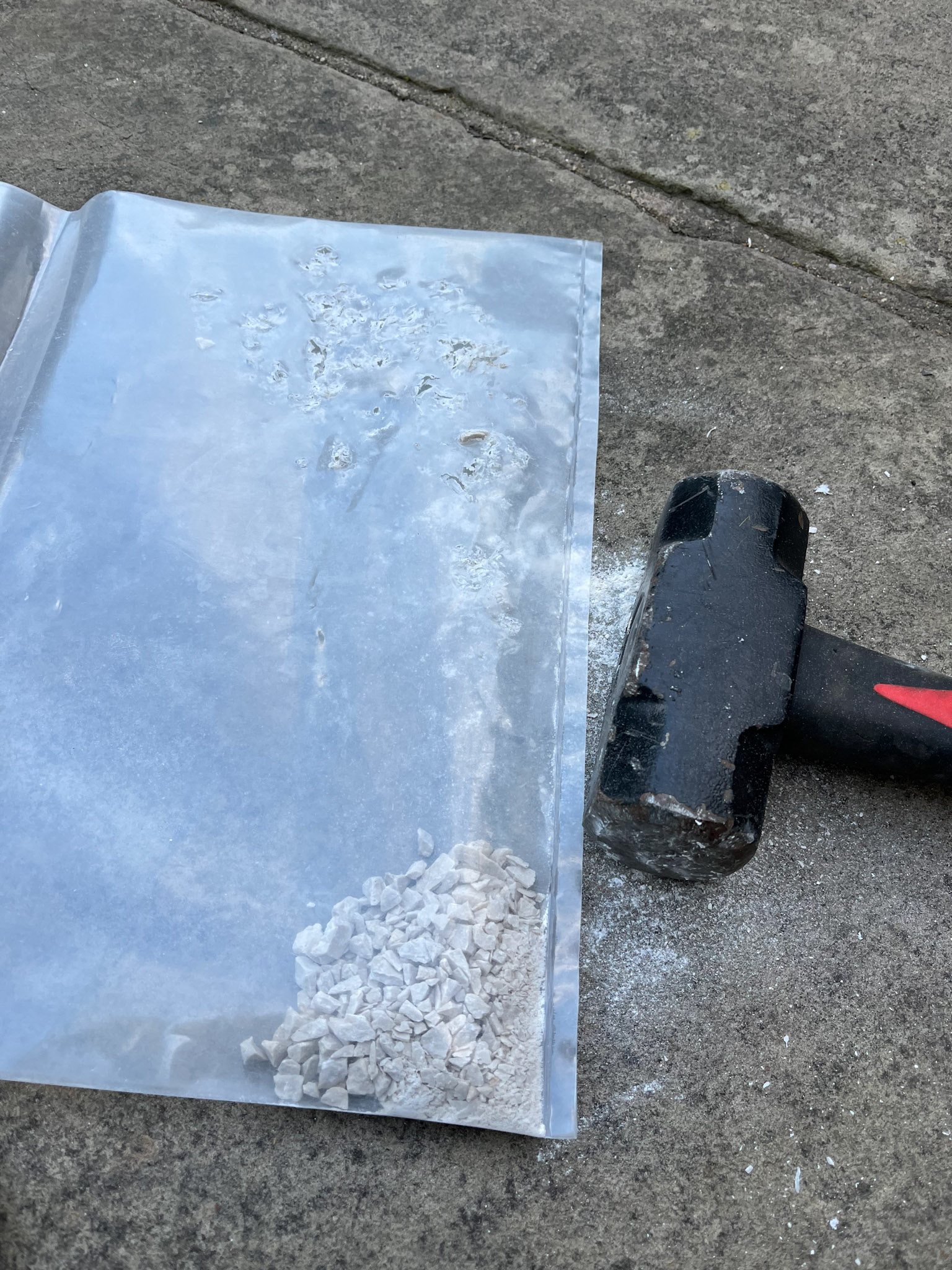
Switched to a bag for more control
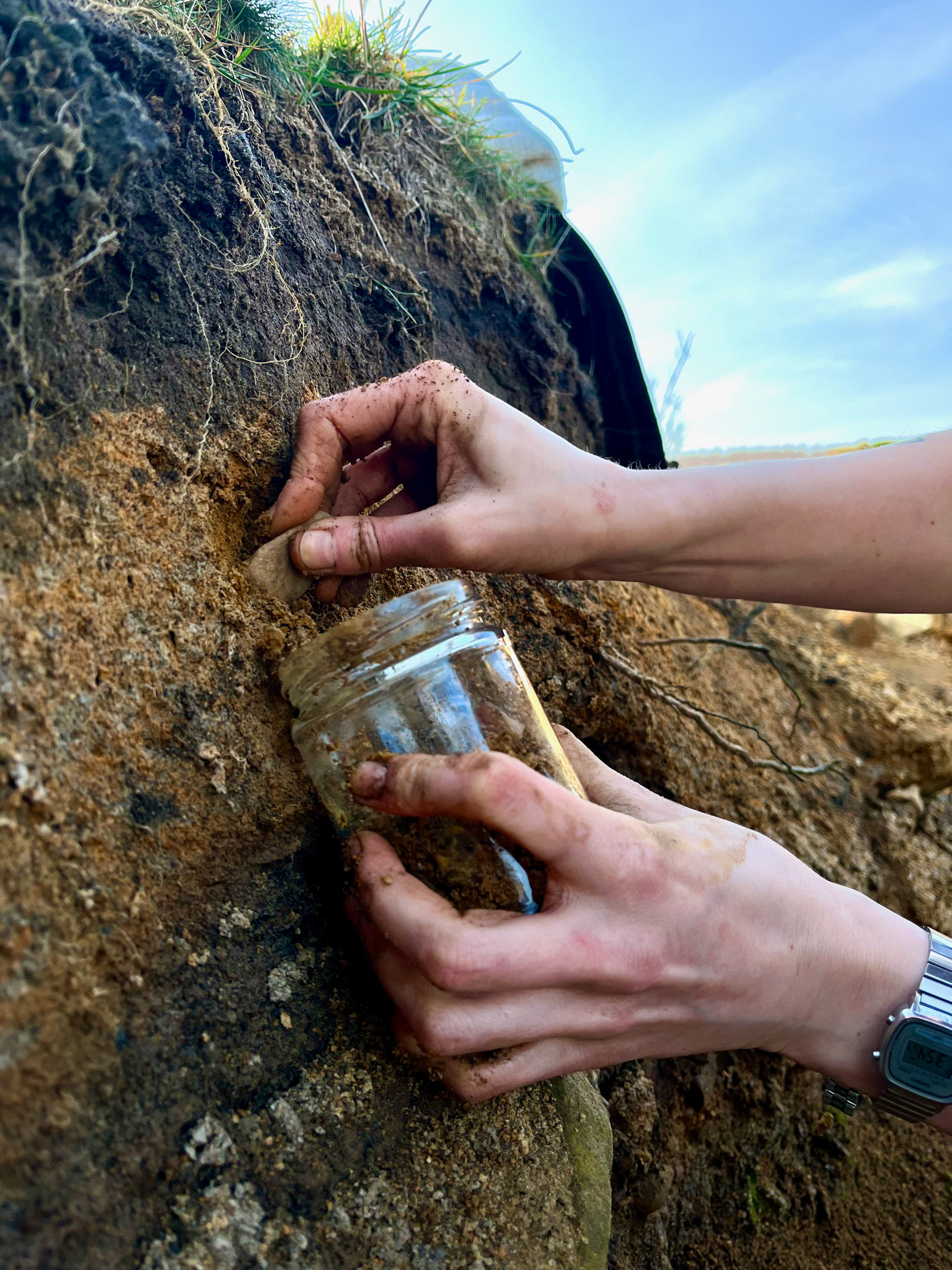
Gathering grit


All the stones/grit collected

Pots side by side; Dark Grit, White Lime
sealing clay
As part of this project, it has always been our intention to work as sustainably as possible with little environmental impact on the earth as we can. With this in mind, we have questioned using kilns to fire the clay, due to the high energy consumption and emissions that firing clay releases.
Looking into various alternatives to using an electric kiln, Abbie and I have researched sustainable ways of setting the clay that don't require unnecessary toxic fumes and high heat temperatures. One of these alternatives is using linseed oil. By applying this oil onto the finished clay pot, similar to the reaction it gives to wood, it will seal the clay and increase its durability. This makes the clay less prone to cracking or warping and acts as a good protector for the clay, which doesn't affect or warp the look of the pot, like firing it would.
The article published in 2022 titled "How to protect terracotta tiles" discusses this method further and was one of the guides that we followed when applying this technique to the communal pots. Terracotta, meaning baked earth, is clay that has been dried out in the sun and is a natural material. It is often used in tiles and is protected by the traditional method of using boiled linseed oil and wax. By doing this technique, which Abbie and I have applied to our pots, it creates a long-term, mechanical strength to the clay, due to effectively filling the pores of the material.
This technique takes quite a lot of time and steps, and we have used boiled linseed oil, which is known as an impregnator, as it is absorbed into the surface of the clay and forms a water-resistant seal. The steps that we have followed to achieve this are as follows:
On the completely leather-hard pots, which have been dried out in the sun for a few weeks, the pots were cleaned and then brushed with a coat of boiled linseed oil until they were fully saturated. After waiting 12 hours for the oil to cure, a second layer of linseed oil is applied to the clay. This process is repeated once or twice more to air dry and penetrate.
Beeswax is also used as part of the process, and acts as a resilient protective layer against water, dust and dirt, and provides a shine to the clay. It is applied by rubbing and buffing the wax into the pot using a cloth, in a similar technique to burnishing. After leaving to dry for at least 24 hours, the pots will be protected and cured.
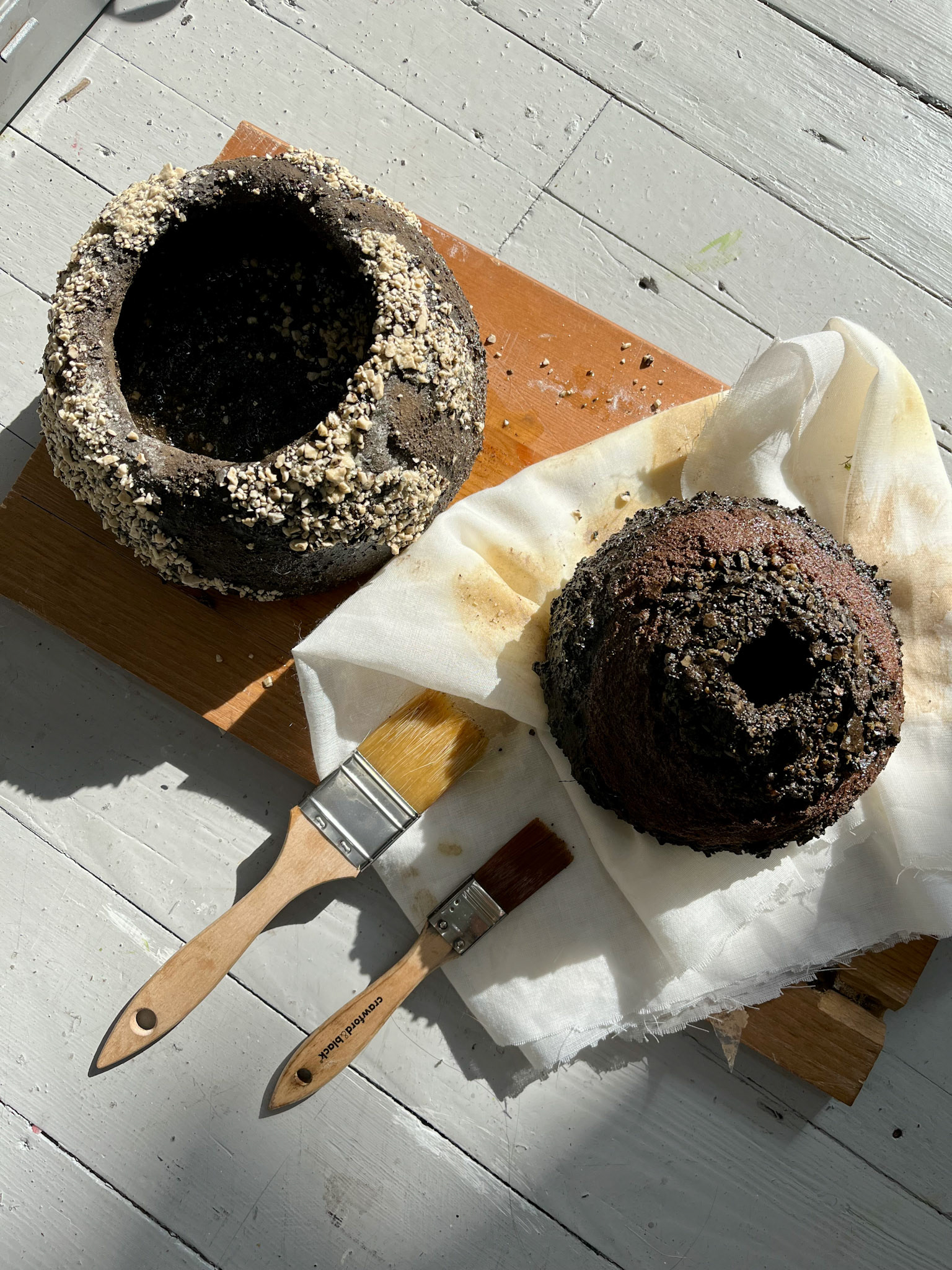
Burnishing pots
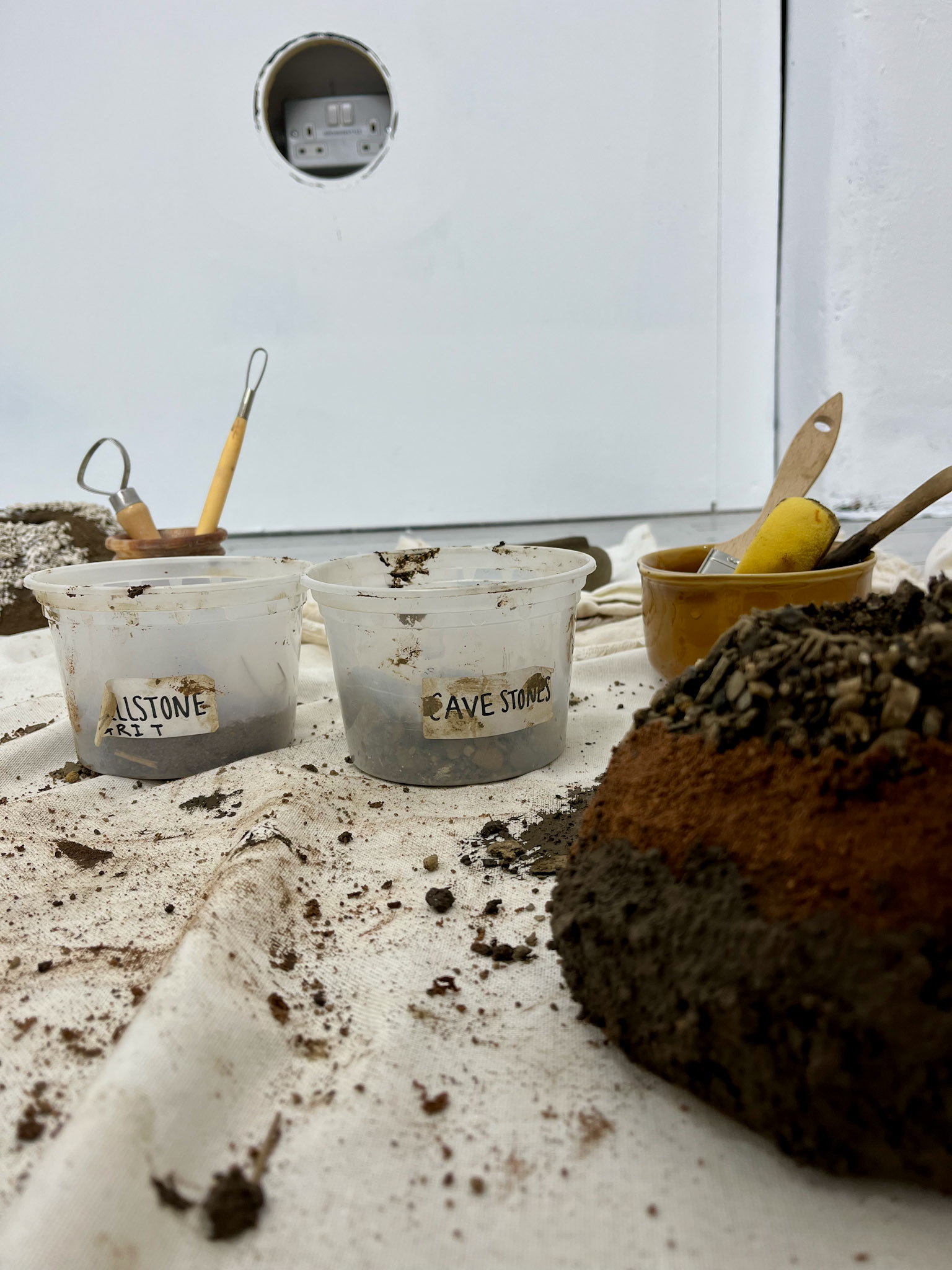
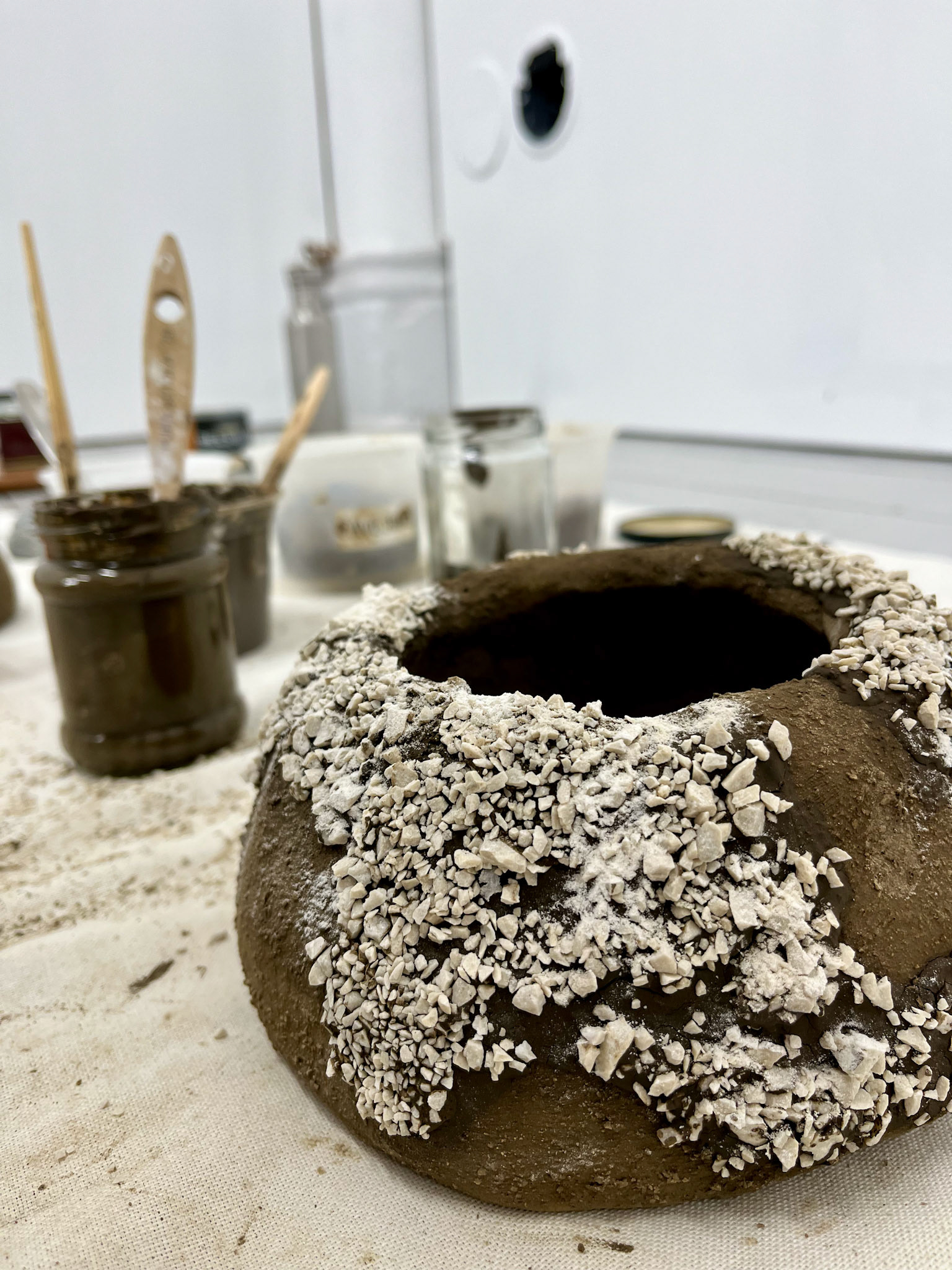
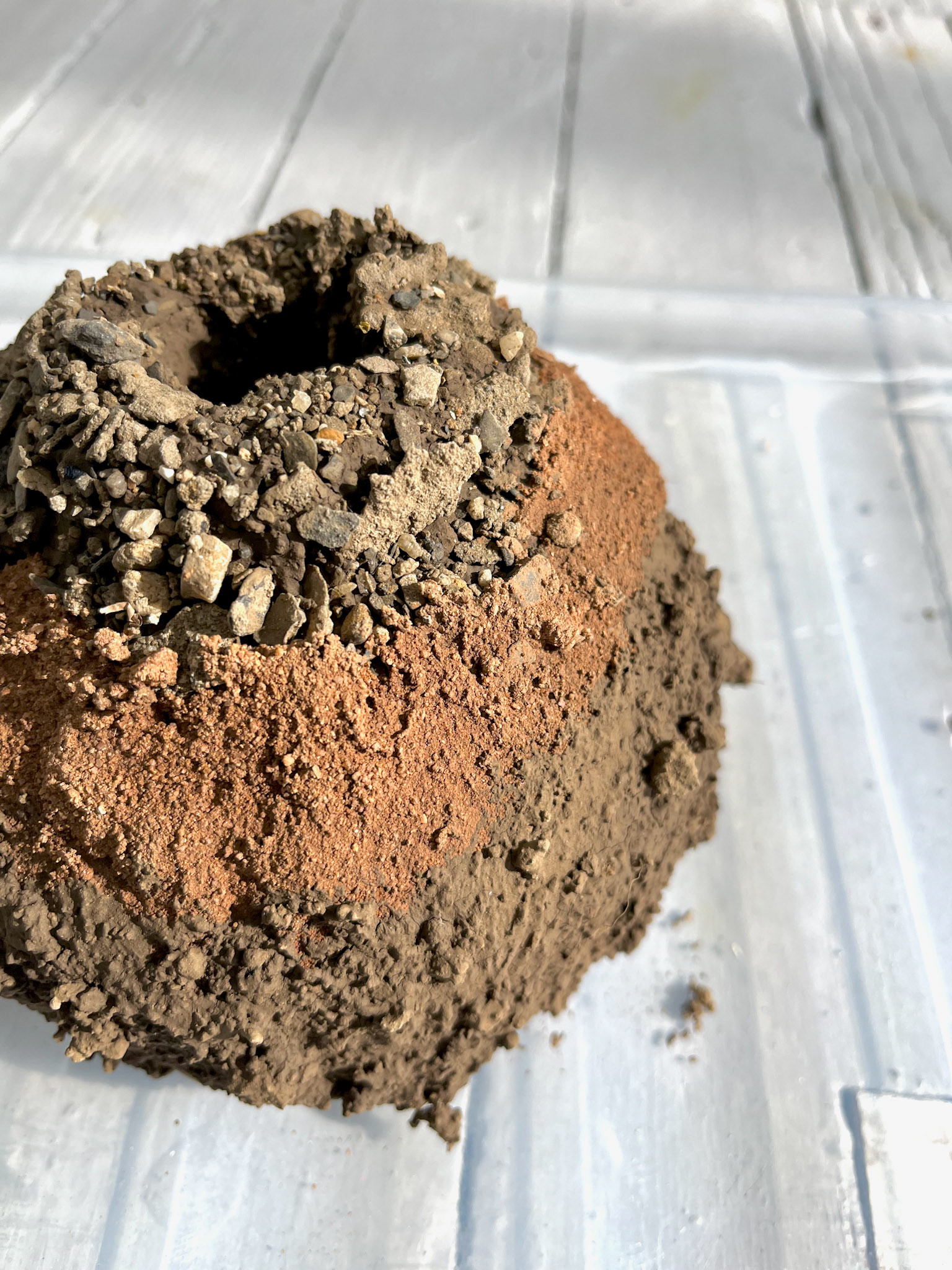
Installation MockUp
The three of us were able to go into the space, which we are exhibiting in the Holden Gallery, to have a mock set-up of the curation for the degree show. This was very useful in thinking of the layout of the plinth with the archaeological style layout of our material discoveries. For the actual installation, we will be displaying the work on a low plinth. However, it will be the exact same dimensions as the fabric we have used for the mockup. The style of the presentation is archaeological due to it being a mapping and recording of our findings from two specific locations. It takes the form of the material findings, such as rocks, grasses and soils that we have harvested from the land, alongside ceramics made from the local wild clay of the caves in the Peak District which I have gathered, which Abbie and I have made collaboratively as a response to the two locations of the White and Dark Peak.
To see the final object resolutions of this project, visit the Resolved Practice section of this collection. The curation of this installation as a whole, with the addition of the projected film with the curtains and also the pamphlet, wall text and poem that the three of us have all made collectively, will be installed after the S&R submission, and available to view in the west wing of the Holden Gallery during the Degree Show.

Box of materials that will be presented
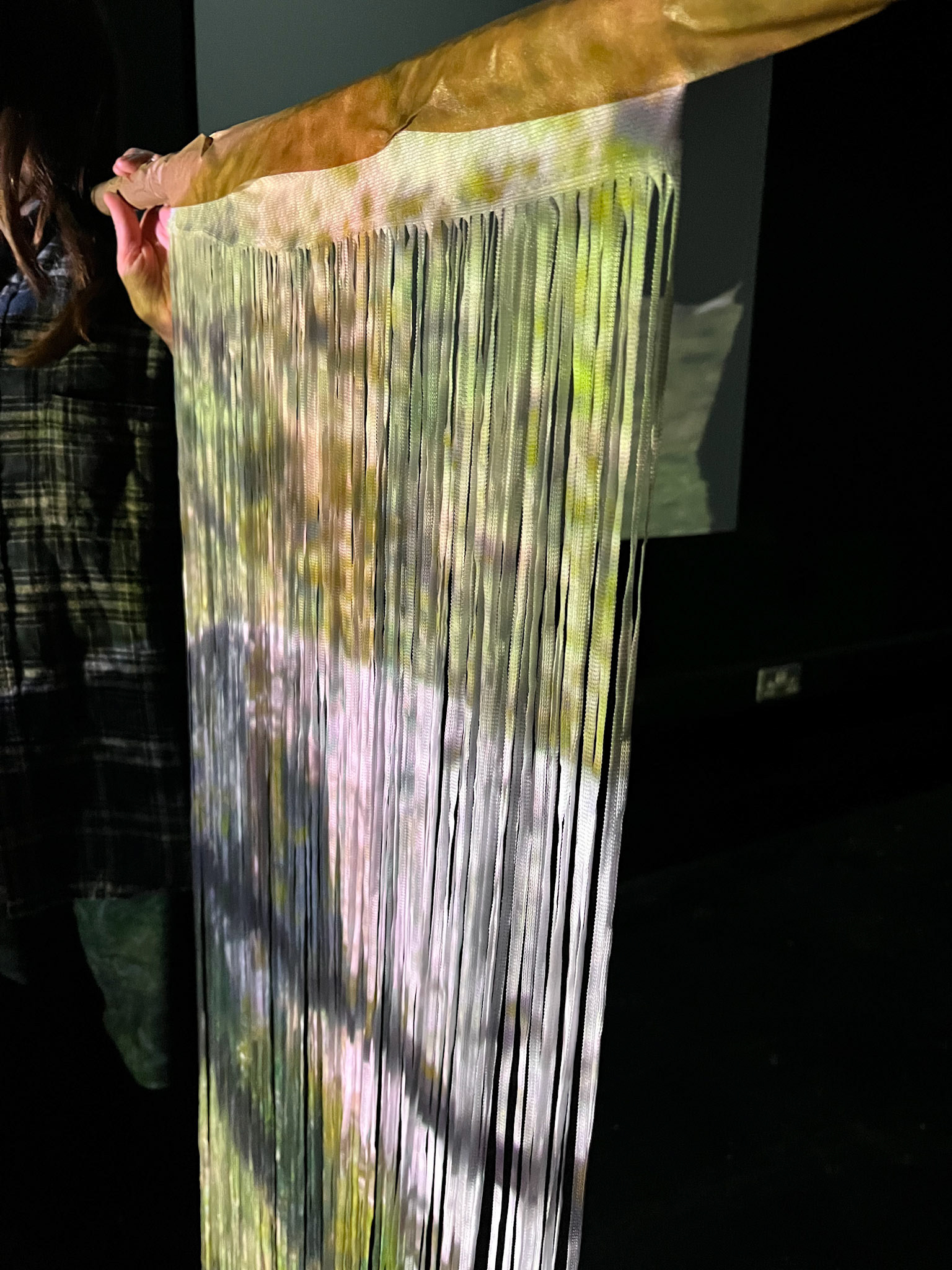
Testing projections
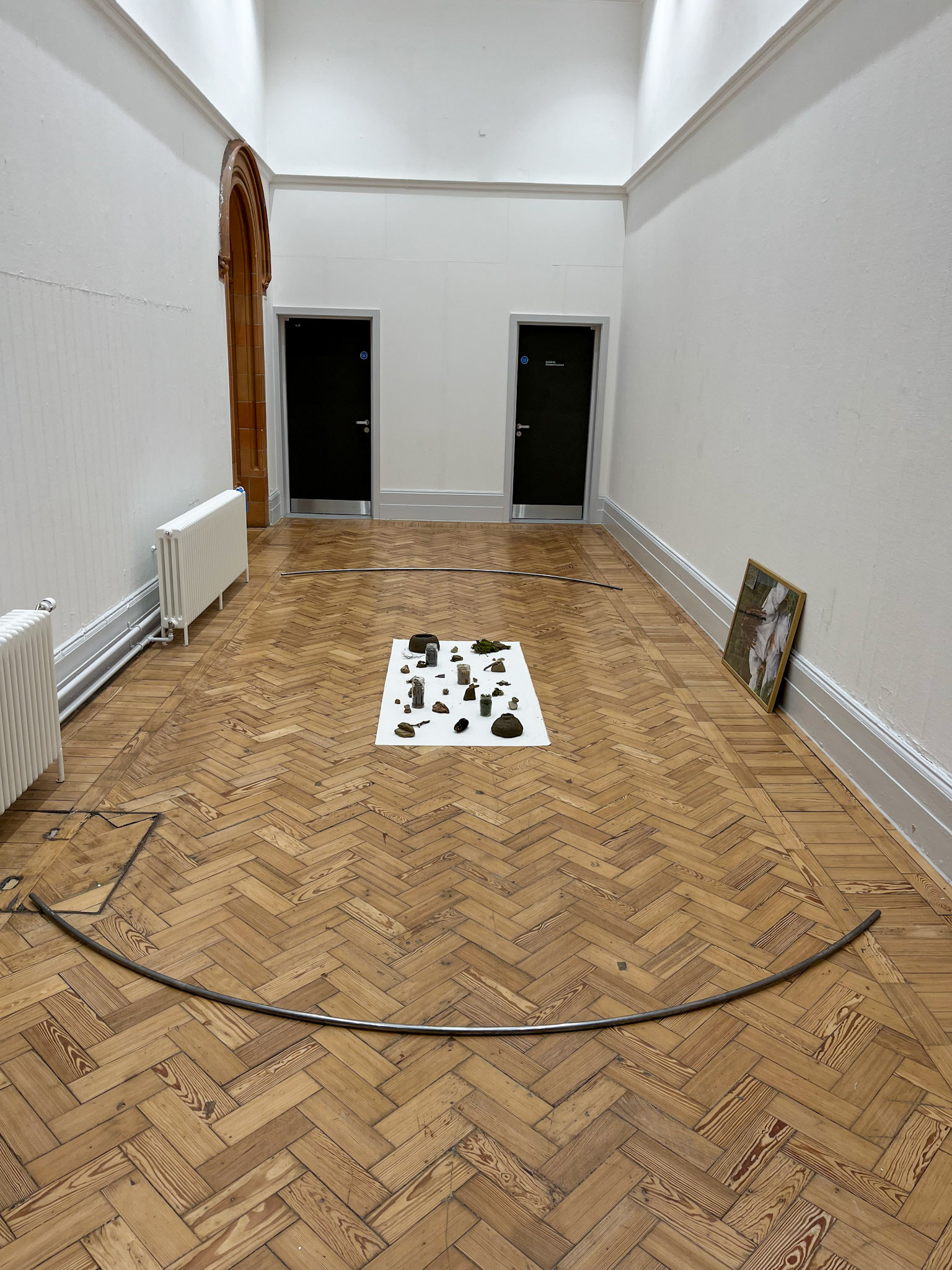
Mock up installation in the space
